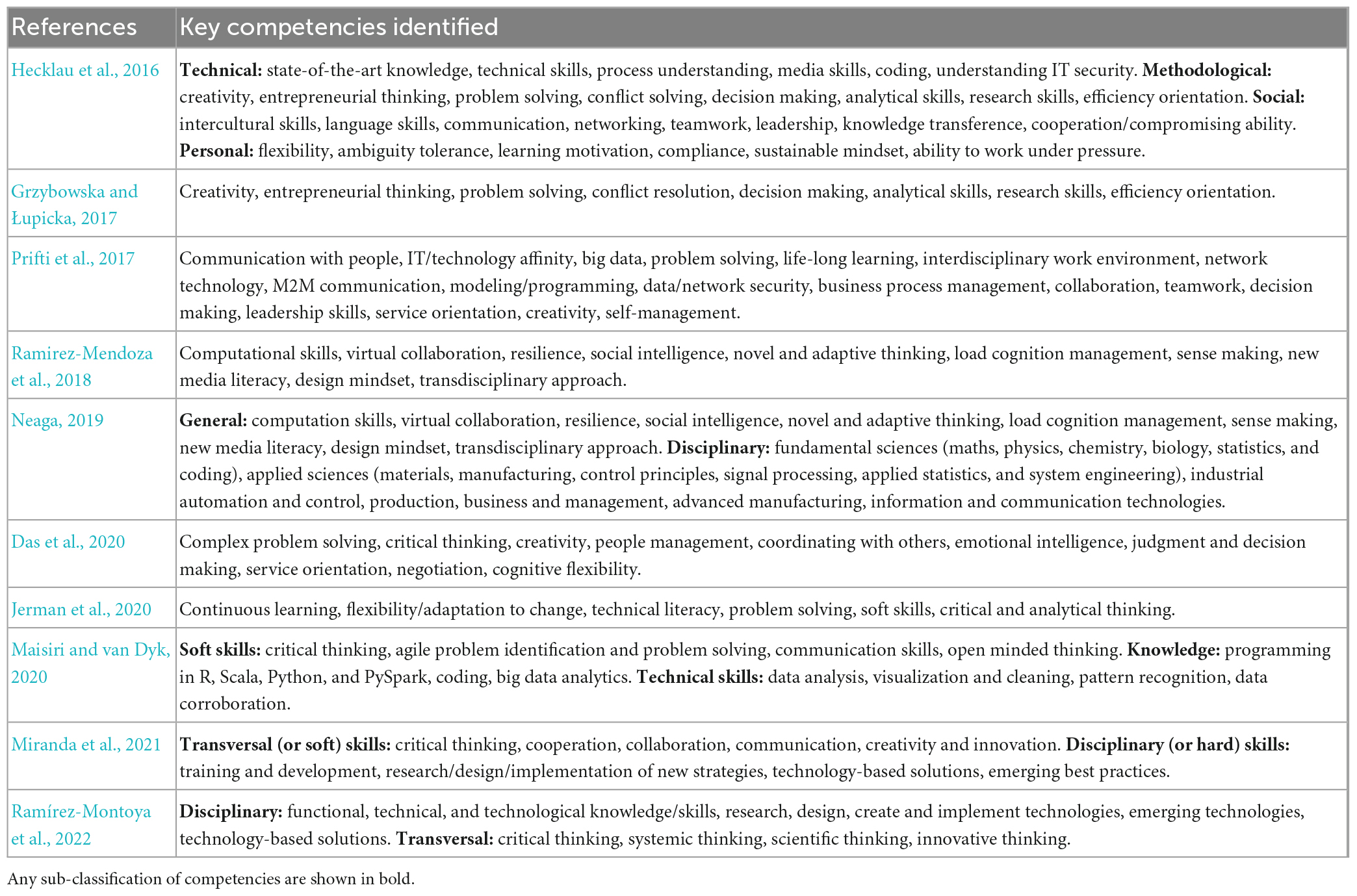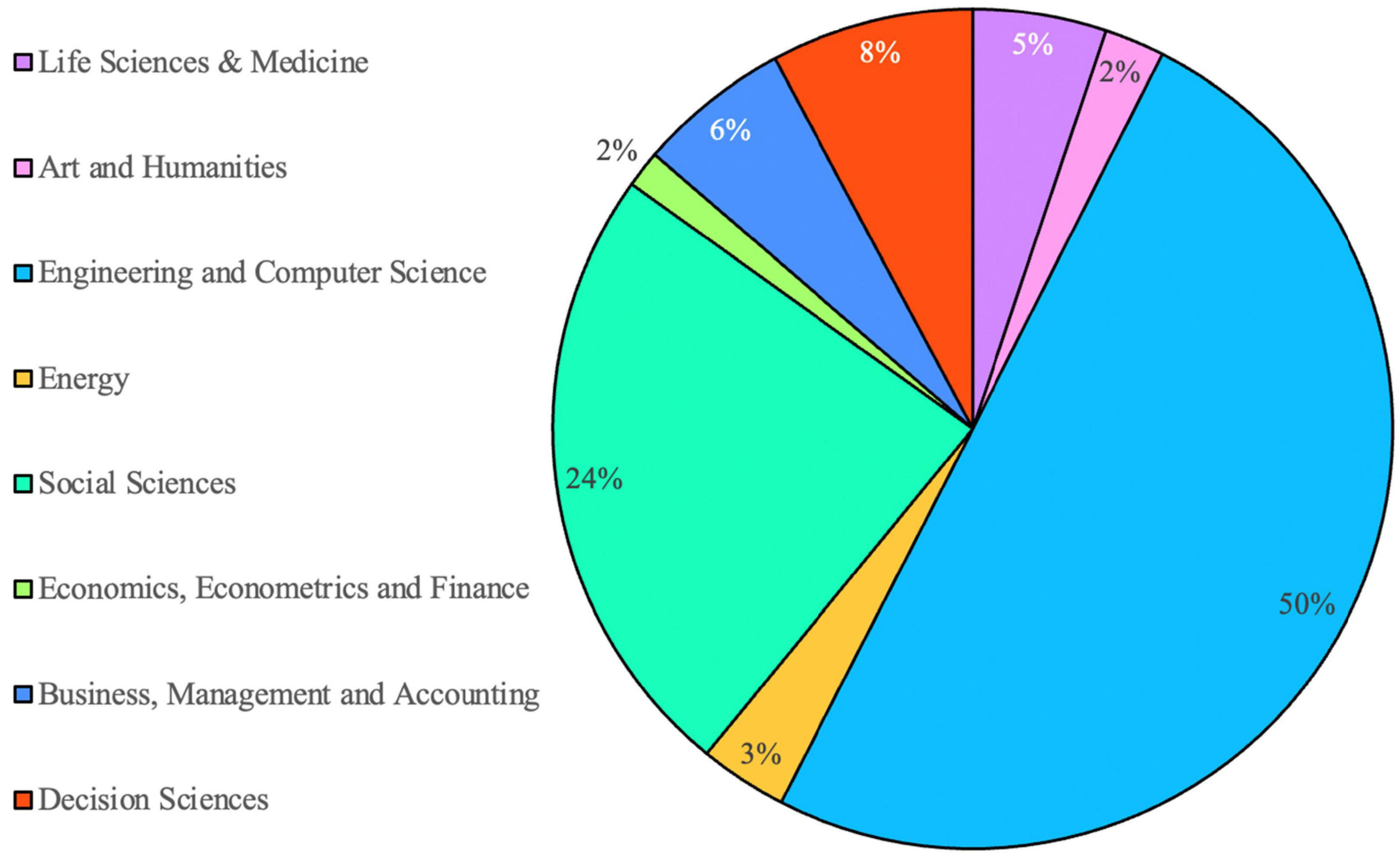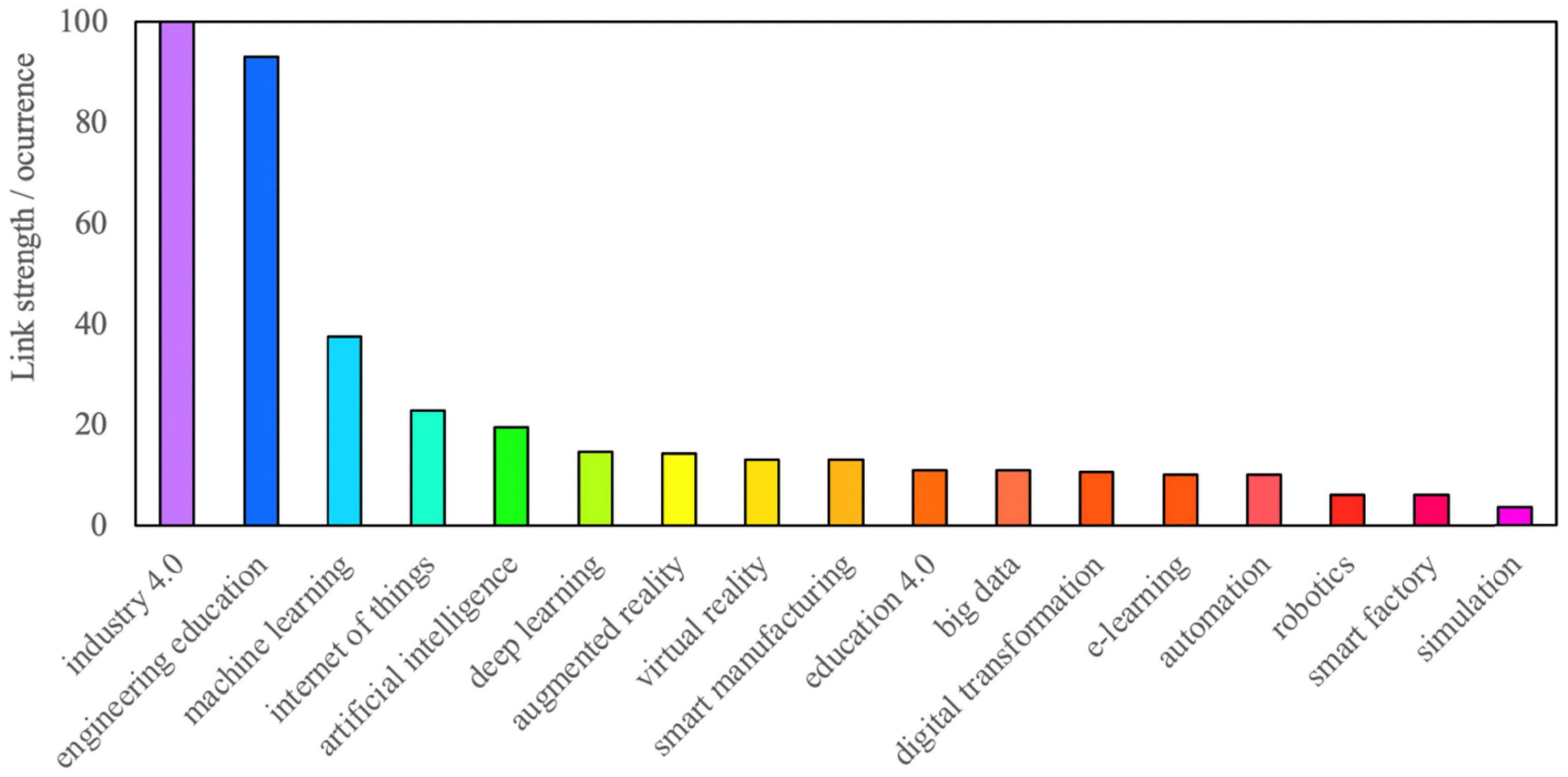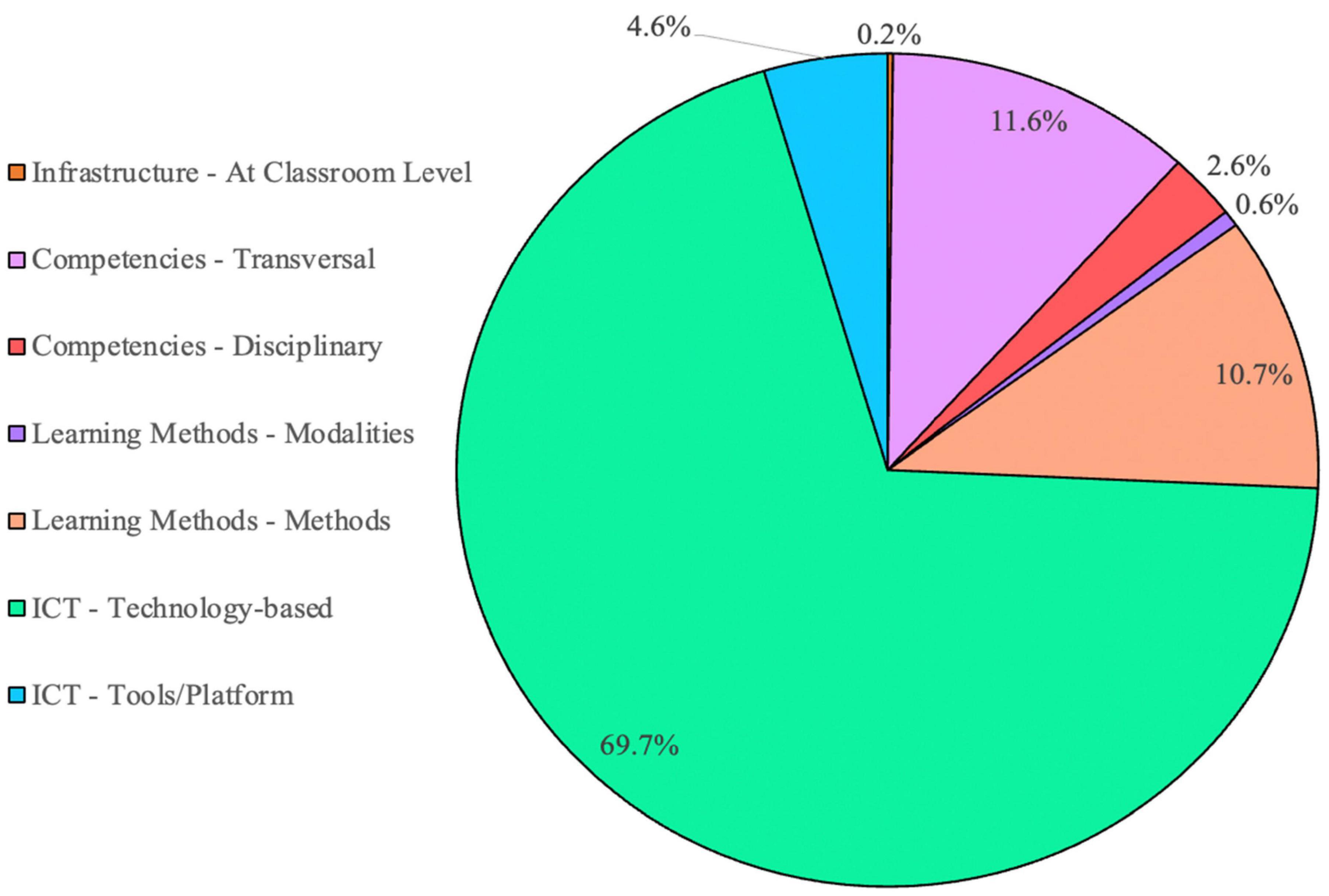- 1Department of Chemical Engineering and Applied Chemistry, University of Toronto, Toronto, ON, Canada
- 2Facultad de Ciencias Naturales y Matemáticas, Escuela Superior Politécnica del Litoral (ESPOL), Guayaquil, Ecuador
- 3Facultad de Ingeniería en Ciencias de la Tierra, Escuela Superior Politécnica del Litoral (ESPOL), Guayaquil, Ecuador
Introduction: The fourth industrial revolution, or Industry 4.0 (I.D. 4.0), has radically empowered professionals to revamp skills and technologies, to match ever-evolving industry demands. Education 4.0 (E.D. 4.0) is an integral education framework, strategically designed to align with I.D. 4.0 needs. The present work presents high-level insights on mapping I.D. 4.0 to E.D. 4.0, by successfully analyzing the four key existing components of E.D. 4.0, namely, learning methods, competencies, infrastructure and information and communication technologies (ICT).
Methods: Research questions are formulated along themes aiming to standardize the E.D. 4.0 framework and identify effectiveness and implementation challenges. These posed questions are addressed by performing an exhaustive bibliometric analysis on the associated literature, by clustering relevant publications by field, year, and geography. We employed the search engines Scopus, Science Direct, and IEEE in a period between January and June of 2022.
Results: Network maps evidence the implementation of E.D. 4.0 elements with no formal and universally adopted framework to map with I.D. 4.0. There is an increasing interest and support from researchers and education institutions in preparing a skilled workforce for I.D. 4.0. Trends of E.D> 4.0-related published articles reveal more implementation efforts in developed countries compared to developing countries.
Discussion: Our results demonstrate a lack of any currently existent, standardized, and universally accepted framework for mapping I.D. 4.0 to E.D. 4.0, despite trends showing a sharp rise towards incorporating E.D. 4.0 initiatives recently into university curricula. Our analysis procedure can serve as a protocol to define E.D. 4.0 in a more specific context, in an ever-changing global workspace. While unbalanced implementation attempts on how extensively E.D. 4.0 components have been defined and adopted (including discrepancies in implementation policies among countries, and across disciplines), further rigorous assessments are needed to critically assess the necessary requirements and effectiveness, for standardization and implementation a global mapping framework.
1. Introduction
Professionals are expected to continue developing skills, technologies, and knowledge, adaptable toward assimilating fast-paced, swiftly changing innovations, driven by the fourth industrial revolution or Industry 4.0 (hereafter, I.D. 4.0), which impact products, services, and production systems (Bauer et al., 2015; Hirschi, 2018; Kipper et al., 2021). Strategic attempts toward identifying these key competencies, as required by future professionals, have been reported in recent years; and has resulted in the identification of “competency clusters.” From an extensive literature review, Hecklau et al. (2016) grouped these competencies into four clusters: technical, methodological, social, and personal. A more recent survey conducted across industries and industry representatives (Mian et al., 2020), have classified clusters by disciplines (engineering, business, design, and transversal). Yet, another survey-based study (Hernandez-de-Menendez et al., 2020) performed across several industries, interpreted these necessary trends to be predominantly technology-driven, and recognized particularly paradigm advances in the field of Artificial Intelligence (AI), owing to the increasing globalized availability of big data, which in turn, propels industry growth. ChatGPT, an AI based chatbot, which was launched in November 2022, has quickly attracted global hype for its promise of enhancing both supervised and reinforcement-based learning techniques across both industry and academia. Despite having some obvious current limitations (such as monitoring and calibration of factual inaccuracies), the parent firm (OpenAI) has been valued at US $29 billion, as of 2023. An overwhelming majority of recent technologies incorporated into the present global industrial market (expectedly) values Machine Learning (ML) as the most utilized skill (87%), followed by user/entity big data analytics (84%), the Internet of Things (IoT) (82%), and cloud computing (76%) (AnTosz, 2018). A major finding from this work is that skills gaps in the local labor market accounts for 59% of the barriers that exist toward the adopting of new technologies. Therefore, it is the need of the hour to swiftly revamp global education to address I.D. 4.0 driven innovation(s), and expand worker competencies/skills, to match industry requirements (Neaga, 2019; Uhlemann et al., 2019; Kipper et al., 2021).
The necessary integral education framework that aligns with I.D. 4.0 requirements is Education 4.0 (hereafter, E.D. 4.0). Several components and defined characteristics are captured in the E.D. 4.0 framework; these have been identified rather recently by some prior researchers (Fisk, 2017; Himmetoglu et al., 2020; Kipper et al., 2021; Miranda et al., 2021). It is imminent that such a standardized pathway needs to be identified and incorporated to approach such problems, as a current lack of standardization negatively impacts the reliability, consistency, and reproducibility of any findings. An unreliable process is difficult to properly analyze, and any associated bias at any step of the analysis procedure ultimately delays a tangible mapping of E.D. 4.0 techniques with I.D. 4.0 requirements, further augmenting an already existent, and progressively increasing, skilled labor shortage.
Even today, there appears to be no universally agreed upon definition or terminology of E.D. 4.0 (Das et al., 2020). Thus, to address the need for having a standardized protocol that can identify, define and shape an effective E.D. 4.0 pedagogical framework, and identify key elements, we performed an exhaustive literature review on the currently existent I.D. 4.0 competencies and compared several approaches, ultimately choosing to merge the most up to date factors identified by Kipper et al. (2021) and Miranda et al. (2021). Once merged, we hypothesized the global need for obtaining a standard E.D. 4.0 definition, as the currently incomplete, scattered framework for I.D. 4.0 will very likely lead to scattered solutions when mapped with I.D. 4.0. A major highlight of our work is to identify and track the most recent E.D. 4.0 competencies, which allows the analysis procedure to be as generic as possible, to ensure maximal success and universality for future mapping efforts. From a comparative study of these competencies, four research questions (RQs) are formulated, which are centered along themes of the extent of successful implementation of the E.D. 4.0 framework, its effectiveness (both perceived and actual), and its associated challenges. Therefore, the objectives that characterize our proposed framework are: (a) identifying the extent to which E.D. 4.0 is presently adopted as a formal educational framework for mapping with I.D. 4.0 requirements, (b) identifying the extent to which E.D. 4.0 components have been already adopted from the formal E.D. 4.0 framework present in the relevant literature; and (c) analyzing implementation trends and challenges of the E.D. 4.0 framework and its associated core components globally, over the last decade. Previous research in this sector has always been limited by the very fact that I.D. 4.0 requirements change over time as industries evolve globally (Wallner-Drewitz and Wagner, 2016): therefore, we recognize that E.D. 4.0 competencies must also change with time to map I.D. 4.0 needs. Thus, to succinctly capture these competences and associated insights, we performed a rigorous bibliometric analysis using VOSviewer, on several research databases, which provided straightforward, simple, objectively unbiased, reliable indicators of the impact, importance, and emerging future trends of this research field. In addition to shaping the proposed E.D. 4.0 framework, our findings are also valuable toward identifying curriculum changes and current pedagogical lacunae, such as modifications in existing course syllabi, the design of new, relevant, strategic programs and courses, etc. Such initiatives are extremely likely to guide the commensurate acquisition and targeted training of precious human capital to drive industry desired changed, as one is easily able to track the evolution and effectiveness of E.D. 4.0 implementation. This paper is structured into the following sections: section “2. Literature review” presents the currently existent E.D. 4.0 framework, and its associated indicators and competencies via a detailed literature review, section “3. Materials and methods” presents the mapping strategy and methodology employed to complete the integral E.D. 4.0 framework, formulates the relevant RQs arising out of this integrated framework, describes the relevant protocols employed toward our bibliometric analyses, and describes the platform that was employed to create these network maps, arising from the bibliometric data. Section “4. Results” presents our results, and section “5. Discussion” thoroughly interprets the results obtained, providing detailed discussion, context, and trends on the visualization and exploration of network maps and graphs, which provides answers to our previously postulated RQs. From the conclusions arising from bibliometric analyses, we propose a more holistic, universally applicable, and representative (and, updated) definition of E.D. 4.0, that is most applicable to the current world. Finally, in section “6. Conclusion,” we present our conclusions, and identify scope for future research work toward mapping E.D. 4.0 to I.D. 4.0 needs in the future.
2. Literature review
Efforts to comprehensively map E.D. 4.0 to I.D. 4.0 needs, have predominantly focused on approaches that typically integrate competency and capability function domains (Wilke and Magenheim, 2017; Das et al., 2020; Jerman et al., 2020; Maisiri and van Dyk, 2020; Agrawal et al., 2021; Silva et al., 2021). Survey-based approaches (Grzybowska and Łupicka, 2017) have identified major E.D. 4.0 components to be decision making, entrepreneurial thinking, efficiency orientation, problem solving, conflict resolution, and analytical skills (in decreasing rank order). More recently, a more “integrated alignment model” was proposed (Lin and Low, 2021) to capture a more synergistic alignment between educational activities, and the I.D. 4.0 demands, as applicable to the Singapore Smart Industry Readiness Index (SIRI). In their approach, road mapping and architecture planning for progressive phases for the integrated alignment model, was linked to four key pillars: connectivity, automation, operation, and intelligence. This exercise was jointly performed alongside an industrial partner, thereby allowing for the identification of E.D. 4.0 tasks per phase. While this approach is definitely synergistic, we hypothesize that in fact, a more clustered approach toward identifying E.D. 4.0 competencies (rather than approaching from a more task-based format), allows for more efficient mapping between these two areas, while also capturing their shared dependencies. From our hypothesis, it follows that the definition and clustering of E.D. 4.0 competencies and their subsequent mapping with I.D. 4.0 requirements, must be approached using a more systematic format; one that strategically aims to list/map them, and then, standardize these requirements cohesively and comprehensively. It is evident that I.D. 4.0 must serve as the starting point for the mapping process, as skills, requirements, and demands of I.D. 4.0 are much more robustly defined by employers and industries (and are also, constantly evolving). In this context, we have already successfully incorporated a specific I.D. 4.0 demand, of understanding “Standards, Codes, and Recommended Practices,” in the chemical engineering sector, at our university (Galatro et al., 2022). Owing to the ever-changing nature of I.D. 4.0 needs, it is not surprising that some prior researchers (Beke et al., 2020) have attempted to identify these competencies by conducting detailed interviews with industries, and surveys with students, to list some identifiable I.D. 4.0 requirements and expectation. Interestingly, some shared requirements also emerged from the expectations of students and industries; these are: complex problem solving, coordinating with others, people management, critical thinking, negotiation, quality control, service orientation, judgment and decision making, active listening and creativity (ranked in 2020, in decreasing order of perceived importance). Eight of these parameters were also ranked important in 2015 (with the exception of quality control and active listening). As the authors themselves state, this work (while commendable) suffers from some limitations, such as the lack of industry representation (interviews limited to the car industry), geographic limitation (student interviews were conducted only at one university in Hungary) and a drastic lack of representation among disciplines (survey limited to mechanical engineering). Additionally, there was no attempt to systematically categorize any identified competencies, which reinforces the need for analyzing this problem through a more structurally rigorous yet sound lens.
Hernandez-de-Menendez et al. (2020) have identified key competencies for I.D. 4.0, by analyzing various models that assess the maturity and readiness of companies to shift to I.D. 4.0 frameworks. Through a global-centric assessment, identified competencies were grouped into three broad categories: methodological, social, and personal. But it must be noted that these competencies were identified only for three disciplines (engineering, business, and design); therefore, no insight about desired competencies in other disciplines such as science, humanities, etc. were obtained. The work concludes by recognizing that there remains no universal consensus on required I.D. 4.0 competencies, and there may in fact be other more systemic economic/social barriers at play which prevent its successful incorporation (firms may choose not to shift toward I.D. 4.0, fearing higher economic expenditure; and employees may prefer not to adapt to newer, ever changing industry demands).
More recent characteristics of I.D. 4.0 have been identified more recently by Mian et al. (2020), as customization, real-time monitoring, productivity, flexibility, logistics, product design/prototyping, resource allocation, responsiveness, sustainability, process reliability, and predictive maintenance (and there may be many others that could exist, some of these characteristics may pertain to more specific industries). An attempt to map I.D. 4.0 has recently been performed by Maisiri and van Dyk (2020), who developed a Competence Maturity Model (CMM), with three domains for competency, capability functions, and maturity level. Each domain has two dimension which encompasses both knowledge and skills (technical vs. soft) requirements. While the capability domain has ten dimensions (all related to industrial engineering), and the maturity level has five dimensions (in line with the industrial revolution); all of which were identified by a systematic mapping review of 283 published papers (out of which only 25 papers were included for the purpose of data abstraction). While clearly conceptualized, well-supported, and efficiently implemented, the competencies are exclusively limited to industrial engineering, thereby preventing its global application across other fields/disciplines.
A more thorough (and recent) literature review has been credited to González-Pérez and Ramírez-Montoya (2022) who propose eight key (RQs); and we also follow a similar approach when formulating our RQs in section “3.1. Hypotheses and research questions” to identify components that use the E.D. 4.0 framework, from 113 reports (out of these, 56 are finally analyzed). The data predicts a major shift occurring in pedagogical practices, with case studies and targeted teaching/learning strategies to gain prominence over the 21st century. Learning methods and competencies are found as the most addressed components of E.D. 4.0, while a scarcity of frameworks are identified, which aim to address strategies to strengthen pedagogical innovation, especially at the school level. These limitations, in turn, become the merits of this work, namely: (a) the selection of a robust framework to assess core components in educational initiatives/projects, and (b) the identification of trends in the identified competencies for various crucial players such as researchers, trainers, and decision makers. The initiatives and projects in this study were evaluated using the core components framework, defined by Miranda et al. (2021). The work successfully develops a comprehensive E.D. 4.0 framework, based on four critical components: competencies, learning methods, infrastructure, and information and communication technologies (ICTs). This framework arises from a compilation of research elements, structures, and concepts across several infographic sources that align with E.D. 4.0 concepts (as summarized in Tables 1, 2). However, the case studies reported by Miranda et al. (2021) are localized to Mexico City and surveyed an English/Spanish-speaking student body; and therefore, suffer from geographical and linguistic restrictions.
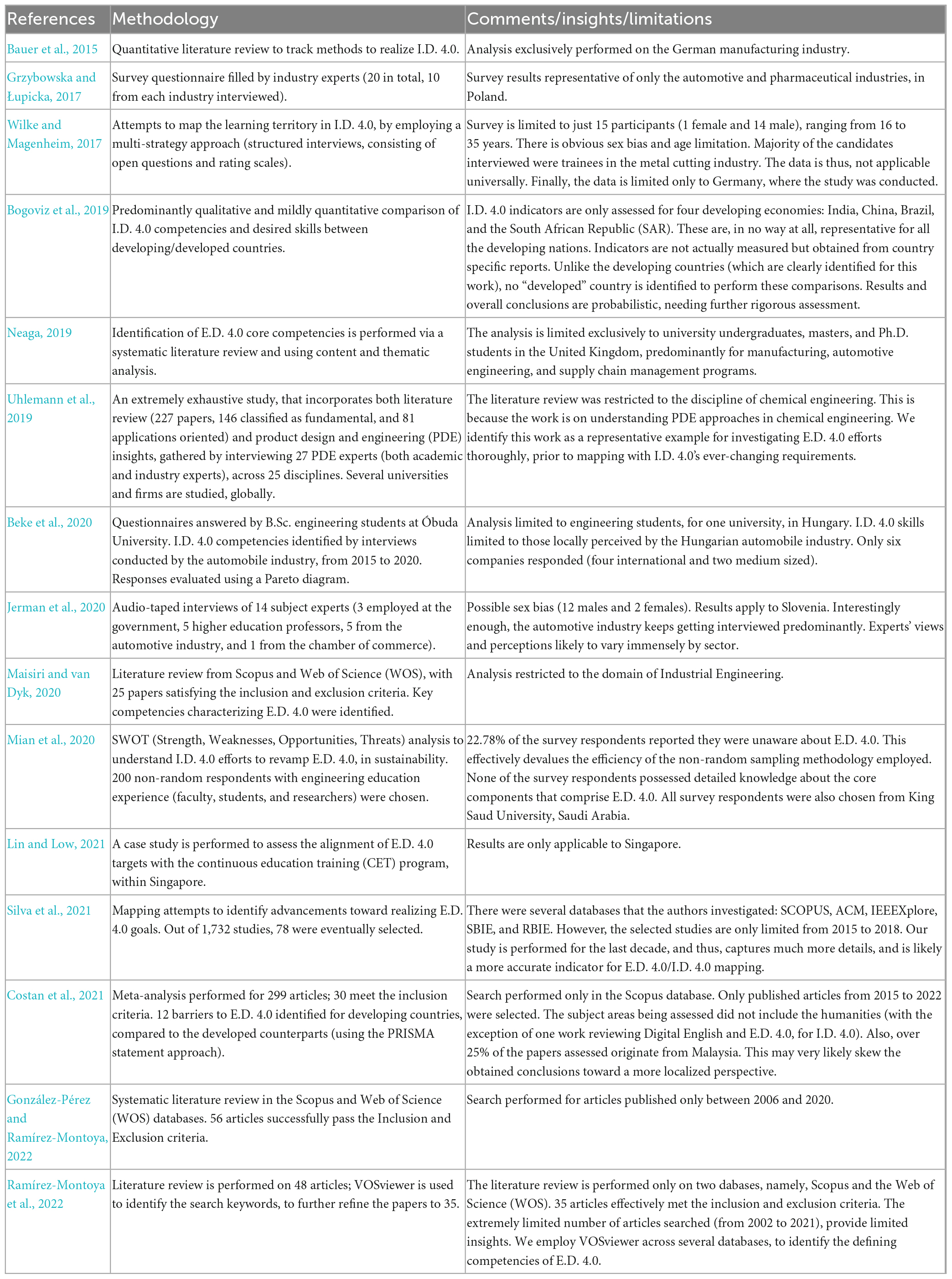
Table 1. A summary of key prior attempts by researchers, to map E.D. 4.0 to I.D. 4.0, and limitations.
A summary of some important prior works, with their employed methodologies, and limitations toward mapping these competencies effectively, are presented in Table 1. We have focused predominantly on experimental/literature review-based works, which have attempted to characterize and/or map these two factors. While the works listed represent a conscious academic effort toward mapping, Table 1 also justifies the need to perform a more exhaustive bibliometric analysis, which can overcome the inherent/identified limitations in these prior works. For our bibliometric analysis, the Inclusion and Exclusion criteria is kept globally applicable, to ensure that our results are applicable in the broadest possible context, thereby paving the way for pursuing more rigorous, detailed studies in the future.
An extremely detailed approach toward identifying E.D. 4.0 competencies related to the qualification of professionals for I.D. 4.0 has been recently performed by Kipper et al. (2021) by surveying the literature with the SciMAT scientific mapping software on the Scopus, Web of Science, and Science Direct databases. The mapping resulted in the generation of a conceptual map, highlighting the major competencies (leadership, strategic vision of knowledge, self-organization, offering and receiving feedback, pro-activity, creativity, problem-solving, initiative, interdisciplinary teamwork, collaborative teamwork, innovation, communication, adaptability, flexibility, and self-management) and knowledge (information and communication technology, algorithms, automation, software development and security, data analysis, general systems theory, and sustainable development theory) required for the successful transformation of firms toward I.D. 4.0 targets. While this exhaustive search omits “learning methods” and “infrastructure” as core components; it nevertheless identifies some essential elements that may be clustered in the competencies and ICTs components, proposed by Miranda et al. (2021). The work of Kipper et al. is also much more universally applicable, as the bibliometric analysis is not limited to a specific discipline, and therefore, the conclusions hold much more universally. Table 2 presents a summary of E.D. 4.0 competencies, as identified by some prior works.
It appears that a very impactful strategy toward the identification of any existent relationships and/or mapping efforts toward linking E.D. 4.0 to I.D. 4.0 is bibliometric analysis (Janik and Ryszko, 2018), and this is the approach we resort to in this work. With the advent of technology, in an increasingly digitized world, it is strategic to resort to computer-based analysis techniques. To ensure that the articles matching the first bibliometric criterion are indeed accurate and relevant, it is customary to refine the results further, to obtain the most accurate results, by implementing an inclusion and exclusion criteria. While this is definitely a robust procedure, which leads to successive refinement of data; it often results in a rather small final set of article database to base analysis/comparison/conclusions on. A summary of past bibliometric analyses performed on the E.D. 4.0/I.D. 4.0 literature, and the effective number of articles finally analyzed, are presented in Table 3.

Table 3. A summary of some key prior literature review/bibliometric analyses, that attempt to understand, classify, and/or capture/map E.D. 4.0 to I.D. 4.0.
The universalization of E.D. 4.0 remains yet another unaddressed challenge, in addition to a lack of standardization in defining and applying an E.D. 4.0 framework, which could then successfully map out I.D. 4.0 requirements. As of 2018, the level of I.D. 4.0 implementation for developing nations was captured at the corporate level, with strategies adopted by separate countries (Bogoviz et al., 2019); and at the national level for developed nations, with state-based strategies of development. Furthermore, major financial barriers exist on the path toward I.D. formation and their consequential implementation, as well as a gap in terms of the readiness of various socio-economic platforms toward the formation of I.D. 4.0 (Costan et al., 2021). Expectedly, the results in ultimately forming I.D. 4.0 targets currently reveal a 5-year gap between developed and developing countries. Such imbalance in implementation strategies must also be considered by researchers, when future attempts to map E.D. 4.0 to I.D. 4.0 are implemented, as specific systemic barriers exist, that hinder the universalization of the E.D. 4.0 framework. Currently, extremely limited works have been conducted to identify these E.D. 4.0 implementation barriers for developing economies, using the number of peer-reviewed publications as an effort indicator, both during the COVID-19 pandemic, or before. In fact, the recent COVID-19 pandemic has categorically highlighted the stark inequality and resource discrepancies between developing and developed nations, at both economic and social strata (Perry et al., 2021; Wakamo, 2022); this has also directly affected education systems. Some other barriers toward E.D. 4.0 implementation for developing economies are the lack of appropriate ICT infrastructure and widespread access; these might significantly deepen inequality. We also recognize the need for rigorous works to assess the global impact of these outcomes, as the United Nations (UN) Sustainable Development Goal (SDG) 4, which ensures quality education for all, might never be realized unless we take imminent swift action in this field.
3. Materials and methods
3.1. Hypotheses and research questions
Our literature review reveals no existent unanimous consensus toward accurately defining a current E.D. 4.0 framework. This lack of a standardized framework results in the existence of several scattered approaches/solutions toward mapping I.D. 4.0, which creates more imbalance toward tackling these lacunae, from a strategy-oriented perspective. Following a deep dive into the literature, we propose to merge the frameworks of Kipper et al. (2021) and Miranda et al. (2021), since both studies are: (a) fairly exhaustive, (b) based on systematic literature reviews, and (c) extremely recent, thereby ensuring up-to-date completeness of required competencies, since the fields of E.D. 4.0 and I.D. 4.0 continually evolve. We refer to this combined framework as the “reference framework” for our analysis. The reference framework is identified by incorporation of a set of E.D. 4.0 elements identified by Kipper et al. (2021), which are then assimilated into the core components’ competencies (transversal and disciplinary) and ICTs (technology-based and tools and platforms) of Miranda et al. (2021), as presented in Table 4. The identified elements in the reference framework are used as keywords or search parameters, when applying the inclusion and exclusion criteria set for our database. A systematic literature search (SLS) is conducted first to analyze these articles, supported by a bibliometric analysis performed using VOSviewer. The software analyzes databases, based on the Visualization of Similarities (VOS) algorithm, as proposed by Van Eck and Waltman (2007), which visualizes both direct and indirect connections between entities, by classifying these relationships into one of three categories: network, overlay, or density (Ejsmont et al., 2020). The strongest clusters typically appear in the center of the generated color-coded plot, and signify a contribution/factor that relates strongly, and more diversely (Waaijer et al., 2011), among the papers analyzed in the database. The exact refinement criteria employed for our review arise from the protocol detailed by Verner et al. (2012), which begins by posing appropriate RQs, executing the search process to obtain an initial number of articles. The articles identified from this first search are further refined through the inclusion and exclusion criteria (to obtain a smaller number of even more relevant articles), and then, selecting and extracting the relevant data. Section “3.1. Hypotheses and research questions” describes these details in more detail, as applied in the context of this work. From this refined dataset, we aim to capture the most updated mapping tendencies of E.D. 4.0 to I.D. 4.0, by formulating a set of RQs, after identifying the key objectives this work seeks to address; these are as follows,

Table 4. Additional elements incorporated into the core components of E.D. 4.0 presented by Miranda et al. (2021) to obtain the combined reference framework.
(a) Identify the extent of E.D. 4.0, adopted as a formal framework toward mapping I.D. 4.0,
(b) Identify the extent of adopting E.D. 4.0 components from the “formal” E.D. 4.0 framework: and
(c) Analyze trends toward implementing the E.D. 4.0 framework and its core components, over the last decade.
Having identified our “reference framework,” the above three objectives are investigated as follows. Objective (a) is assessed by identifying the generated clusters, weight attributes, and skewness of E.D. 4.0 elements, from the visual network information generated by VOSviewer. Objective (b) is studied by identifying E.D. 4.0 components from our reference framework, which currently exhibit a lack of standardization. As a direct consequence, this exercise results in the identification of novel elements which can ensure a complete, updated mapping framework. Finally, objective (c) is studied by investigating trends in implementing our reference framework over the last decade and identifying major indicators of implementation and/or mapping efforts. It is noted that our proposed three objectives focus on two thematic issues: the standardization of the E.D. 4.0 framework, and its effectiveness and progress made toward implementing it. An additional theme is also recognized as scope for future work, namely, the challenges which exist toward implementing E.D. 4.0 between developed and developing countries. We hypothesize that implementation trends our reference framework might be considerably different across these two socio-economic groups.
To realize our identified objectives, four RQs are formulated, as summarized in Table 5. These are as follows:

Table 5. Themes and research questions formulated to test the objectives, in the reference framework.
RQ1: To what extent has E.D. 4.0 been integrated as a framework for mapping with I.D. 4.0?
This question aims to identify the VOSviewer generated plots, which can provide insights on how much of E.D. 4.0 currently aligns toward I.D. 4.0 targets, and how much mapping work remains to be performed. RQ1 is primarily aimed at addressing objective (a), and these insights generated from the bibliometric analysis will strategically identify the scope of future mapping endeavors that should be performed.
RQ2: Which E.D. 4.0 components are successfully identified in the literature, out of the composite E.D. 4.0 framework?
The purpose of this RQ is to identify objective (b) and recognize two important factors: the components which have been successfully mapped out from the E.D. 4.0 literature, and the components that are yet to be mapped out from our reference framework. Together, RQ1 and RQ2 are formulated to test our hypotheses about the lack of a standard implementation of E.D. 4.0 framework, to meet I.D. 4.0’s ever-evolving requirements. As we will shortly see, this exercise results in a novel, revamped identification of E.D. 4.0 competencies, as I.D. 4.0 demands continue to evolve with time, across an ever more competitive global workspace.
RQ3: How have RQ1 and RQ2 been addressed, over the past decade?
This RQ is aimed to investigate objective (c), through comparative (literature reviews) and visual (VOSviewer maps) studies. The choice of a decade was considered an appropriate timeline to track the temporal variation in E.D. 4.0 requirements, as a response to I.D. 4.0’s ever changing requirements. RQ3 attempts to investigate and capture these temporal trends regarding E.D. 4.0 research as a unified framework, or present core components of E.D. 4.0 outside of the reference framework. By analyzing the trends obtained from these plots, in the context of RQ3, we successfully identify the core competencies of E.D. 4.0 today, and notably, they are somewhat different from the competencies identified during the last decade. This response is expected: as societies evolve and job requirements become even more rigorous and demanding, in an increasingly globalized, AI-driven world, E.D. 4.0 expectations also evolve to match the need to educate adaptive and industrially competent students, over current and future generations. It must be emphasized that while analyzing RQ1-RQ3, the authors have ensured that the data collected is impartial, and applicable globally (not restricted by geographical, linguistic, and or cultural barriers). Consequently, the conclusions obtained from this work are far more universal and applicable across almost every sector today.
RQ4: How do E.D. 4.0 efforts compare between developing and developed countries?
The purpose of RQ4 is directed more toward identifying the scope of future research work in this field, following our bibliometric analysis. It appears evident that the extent to which E.D. 4.0 efforts would be implemented between developed and developing countries, because of (likely) economic, social, political, and systemic barriers. Also, RQ4 attempts to identify the key factors responsible for the gap in adopting the E.D. 4.0 framework between nations, thereby acknowledging a currently existent imbalance of the E.D. 4.0 framework. This should not be perceived negatively, but instead, should serve as a motivator for future research arising out of the framework detailed out in this manuscript.
3.2. Search criteria
To ensure a perfectly unbiased treatment of the search procedure, the search criteria employed several electronic databases, namely, Scopus, Science Direct, and IEEE, which are known to be online repositories for articles published in journals, books, and articles. The search period was between January and June of 2022. The search strings for RQ1 are chosen to be “Education 4.0” AND/OR “Industry 4.0” AND/OR “Fourth industrial revolution,” which led to 384 articles being matched with the search string. These articles are open access, peer-reviewed in journals, conference proceedings, across all languages, and almost 50% of the literature applies to the subject field of “Engineering and Computer Science,” as shown in Figure 1. This is not surprising at all, since this field has seen a tremendous boom over the last decade. Rather, this is reassuring, because it successfully demonstrates that the first filter for our search criteria works well. From this initial dataset, and to obtain a more representative idea about the exact trends that RQ2 seeks to identify, E.D. 4.0 core components were searched exclusively in the domain of “Engineering Education,” where substantial studies have been performed traditionally (in fact, most of the literature cited in this work also happens to be from this field). As is evident from Figure 1, “Engineering and Computer Science” represents 50% of the articles found in the databases, followed by “Social Sciences” at 24%, “Decision Sciences” at 8%, “Life Sciences & Medicine” at 5%, “Energy” at 3%, and “Business, Management and Accounting at 6%” and “Art and Humanities” at 2%.
3.2.1. Inclusion and exclusion criteria
Inclusion and exclusion terms were manually selected from the search list provided by VOSviewer to align found words with all prior identified core competencies. Search words were used as basic search terms.
3.2.2. Data selection and extraction
Records were initially identified through database searching engines, followed by a manual screening process to eliminate duplicates. Text articles were then assessed for title and abstract matches.
3.2.3. Data synthesis
A rigorous bibliometric analysis is conducted via VOSviewer, which allows the creation of maps, based on analyzing the network data of various scientific publications and journals. The maps are created by using bibliographic databases obtained from Scopus, Science Direct, and the IEEE databases. Network maps include items or objects of interest between any pair of items, with a detectable link or connection. Each link is assigned a strength (a positive numerical value); the higher the strength, the stronger the link between the items. Items are also grouped into clusters and may have various attributes, for example, cluster numbers for example. Likewise, weight attributes indicate the relative importance of an item, and an item with higher weight is therefore more important than its lower counterpart. In the network visualization of these maps, higher weight items feature more prominently. To support the discussion of RQ3, supplementary graphs were created in Microsoft Excel, including trends and pie charts. While bibliometric analyses provide some immediate clear advantages such as the quick assessment of research impact and scalability of large volumes of data, additional metrics may be necessitated to distinguish them better, and perform more in-depth studies. We also recognize that bibliometric analyses may even possibly skew the research toward the most cited contents, thus, bibliometric indicators should be treated more as a first filter, which would then serve as a starting point for more detailed pedagogical research. Nevertheless, bibliometric analyses are an extremely practical visualization tool which can successfully cluster large volumes of research data; and further analyses are likely needed to obtain more conclusive insights.
4. Results
In this section, the findings arising from the bibliometric analysis implemented by us are summarized, to answer and add more context to the initially posed RQs. We also consciously present the discussion and identify key strategies that may be employed in the future to map E.D. 4.0 to I.D. 4.0 more comprehensively, considering the gaps in the process, as identified from our literature review.
RQ1: To what extent has Education 4.0 (E.D. 4.0) been fully integrated as a framework for mapping with Industry 4.0 (I.D. 4.0)?
Figure 2 depicts the network map, comprising of several clustered items, related to the posed RQ RQ1. VOSviewer generates six clusters, around highly weighted items, such as performance (virtual reality, simulation, video, and ICT), the internet (IoT, cloud computing, and education system), methodology (flexibility, creativity, and soft skill), quality (blended learning and e-learning), stakeholder (complex thinking and critical thinking), and curriculum (cyber-physical system and augmented reality). There is clear evidence of some core components fitting this mapping model, when searching by the keyword “Education 4.0.” However, some currently missing elements remain yet to be mapped, such as hybrid-based learning, active learning, problem-based learning, technology-based items (ML, big data, data science and data analytics), AI, and infrastructural setups. Our bibliometric analysis also appears to signal toward new emerging pathways (these are the resulting clusters on the map), that characterizes E.D. 4.0 currently; the major ones being methodology, performance, mathematics, quality, internet, video, and AI, and some minor ones being attitude, cloud computing, blended learning, experiment, creativity, sustainability, initiative, complex thinking, IoT, education system, simulation, virtual reality, etc.
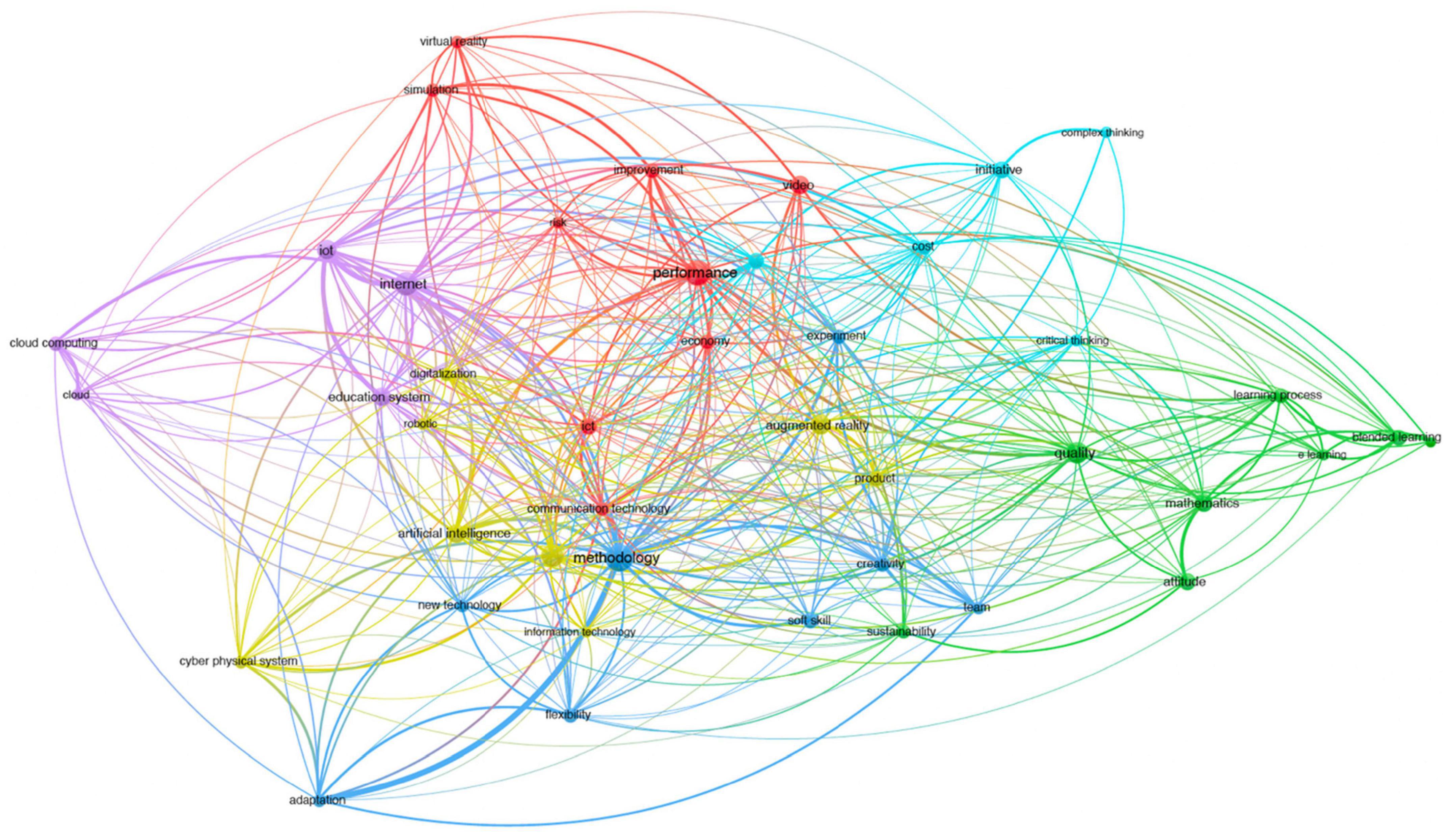
Figure 2. The network map obtained as a response for RQ1, which identifies several research clusters which characterize strategies implemented to map E.D. 4.0 competencies to I.D. 4.0 needs.
RQ2: Which Education 4.0 components are identified in the literature, out of the entire Education 4.0 framework?
RQ2 builds on the key competencies obtained from RQ1, as specifically applicable within the context of the field of “engineering education,” since “Engineering and Computer Science” represents 50% of the articles that were found to answer RQ1. Figure 3 presents the network map generated by VOSviewer (2022), identifying clustered items related to RQ2, by analyzing over 1965 articles (open access, peer-reviewed journals, conference proceedings, and across all languages) found in our databases. VOSviewer generates eight clusters around highly weighted items such as motivation (soft skill, teaching material, engineering curriculum, sustainable development, simulation, collaborative learning, critical thinking, experiential learning, and blended learning), the IoT, modeling (practical implication and technological innovation), cyber-physical systems, big data (cloud computing and data science), algorithms (neural networks and cloud), ML and AI. The links and weights of the clustered items in the mapping represent all core components that E.D. 4.0 comprises of. The articles analyzed in our datasets are over 35 times more than those of Maisiri and van Dyk (2020), over 3 times more than Kipper et al. (2021). It is therefore natural to conclude that the clusters identified from our bibliometric analysis is likely to be much more representative of current E.D. 4.0 competencies, as an immensely larger dataset was fed to VOSviewer for analysis. Simultaneously, our results are unlikely to be restricted by geography and are far more globally applicable, unlike almost all previous work in this field. We observe that there are in fact, several “core” components that comprise the current day perception of E.D. 4.0, and we postulate that these clusters are likely to increase even more in the future, as I.D. 4.0 requirements will likely become even more stringent, across a more-competitive workspace.
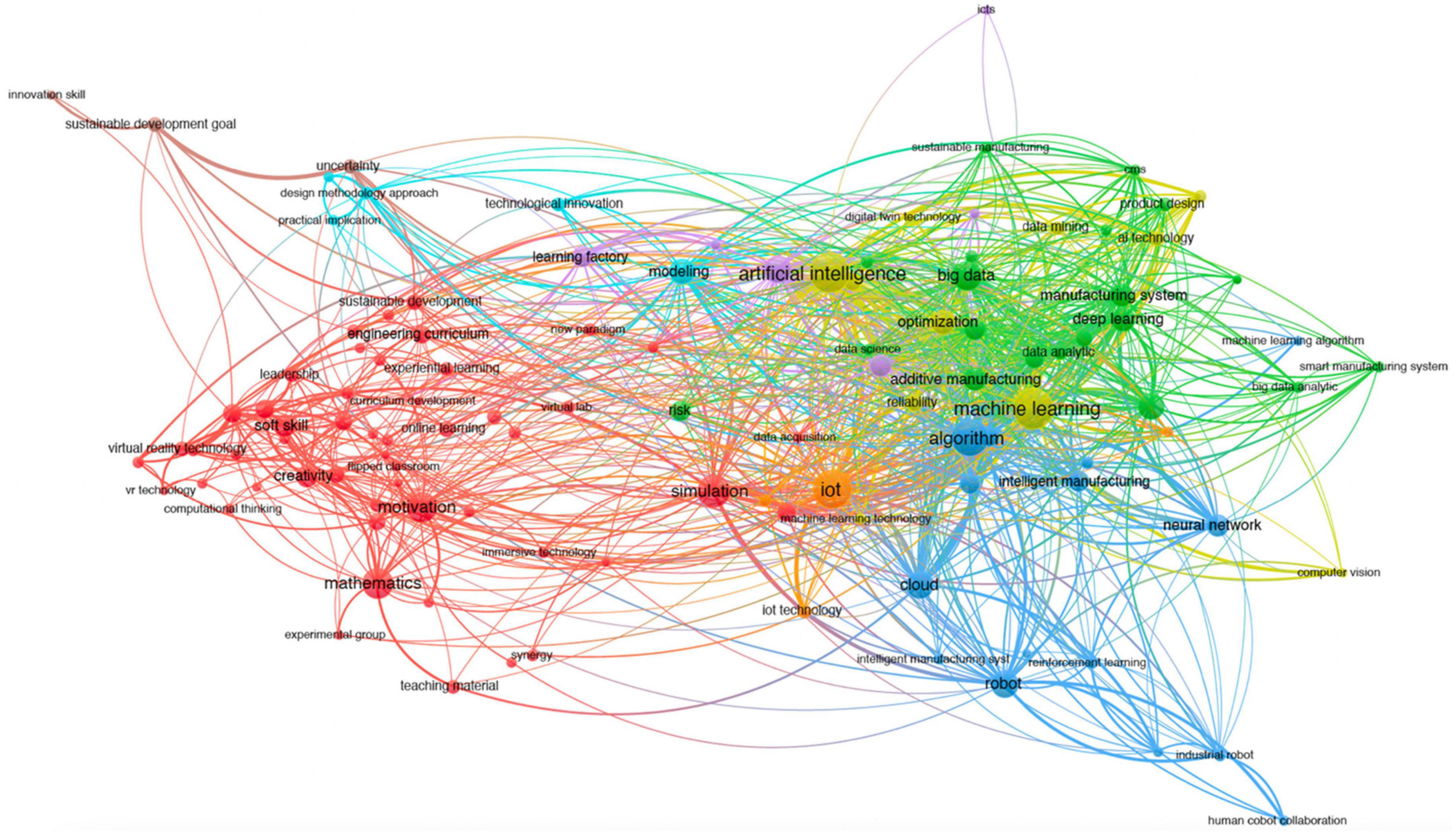
Figure 3. The network map obtained as a response to RQ2, identifying the core components of E.D. 4.0.
The bibliometric analysis provides us with two trackable parameters for each identifiable trends of E.D. 4.0 – the link strength, and the occurrence. While the link strength is a measure of the number of publications where a keyword occurs, the number of times it occurs among the publications identified by the link strength detection criterion, is the occurrence. Figure 4 shows the link strength matches and values arising from our bibliometric analysis; as expected, Industry 4.0 and engineering education are the two keywords that record the largest values, at 100 and 93, respectively. In fact, what these numbers suggest is that almost all publications that study I.D. 4.0, also investigates its relationship with E.D. 4.0. To comprehensively understand the relative characteristics of E.D. 4.0 that are currently perceived as valuable by I.D. 4.0, these two search keywords are removed, and all remaining keywords arising from the bibliometric analysis are analyzed in Figure 5. The trends are most interesting and reveal some notable shift: ML, the IoTs, and AI emerge as the top three contributors to the currently “perceived” definition of E.D. 4.0. This is a stark difference, compared to previous works in the literature, and it appears that a global transformation is occurring. I.D. 4.0’s expectations toward E.D. 4.0 indicates a predominantly technology driven transformation. What is most notable is that almost all the clusters identified are technology-based, and it appears that soft skills-based competencies are perceived less valuable, as the global economy becomes more digitized, and technology-driven. Figure 6 groups these keywords by relevance index into the four core components of E.D. 4.0; this index is estimated as the average total link strength and the number of occurrences reported by VOSviewer. The results are extremely enlightening: 70% of research in Engineering Education aims to tackle to core component of ICT, followed by transversal competencies (11.6%), learning methods-methods (10.7%), ICT based tools/platforms (4.6%) and others, grouping the rest of components (3.1%). We also note that Competencies (14.2%, as a sum of the Transversal and Disciplinary contributions) and ICTs (74.3%, as the sum of Technology-based tools/platforms) are components that remain fully aligned with the current essential competencies (Miranda et al., 2021), and trends driving industry growth (Hernandez-de-Menendez et al., 2020). The major conclusion that arises is that the traditionally identified components and competencies of E.D. 4.0 do not apply as much, and a new definition of E.D. 4.0 must be proposed, keeping in tandem with the current trends and expectations of I.D. 4.0.
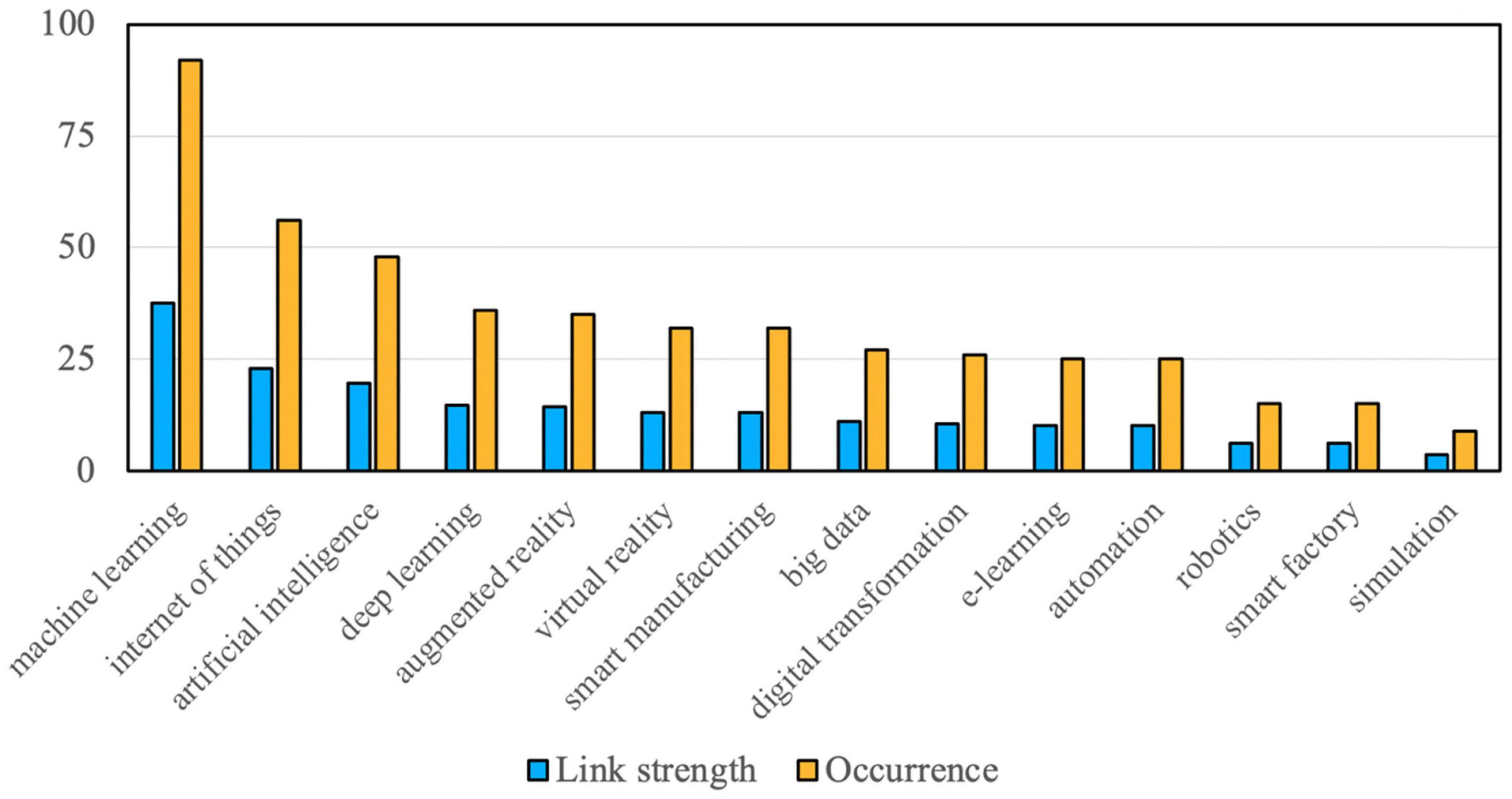
Figure 5. Link strength and occurrence values for the identified clusters arising from our bibliometric analysis.
RQ3: How have RQ1 and RQ2 have been answered over the past 5 years?
Figures 7A, B present publication trends of articles published from years 2017 to 2021 pertaining to “Education 4.0” (RQ1) and “Engineering Education” (RQ2). Trends show a fairly robust increment of publications over the last decade, with the exception of “Engineering Education” during 2020–2021, which show no significant difference in the number of publications. These trends are extremely revealing, as it confirms a rapid increase in interest within the academic community, to comprehensively understand, characterize, and map the structural and functional components of E.D. 4.0 and I.D. 4.0. This trend is very promising and forms a very firm basis for the motivation of this work. Through the methodology and analysis procedure formulated by us here, we are hopeful that this protocol will be adopted by future researchers, to successfully map E.D. 4.0 competencies to I.D. 4.0 demands, as both sectors continue to evolve with time.
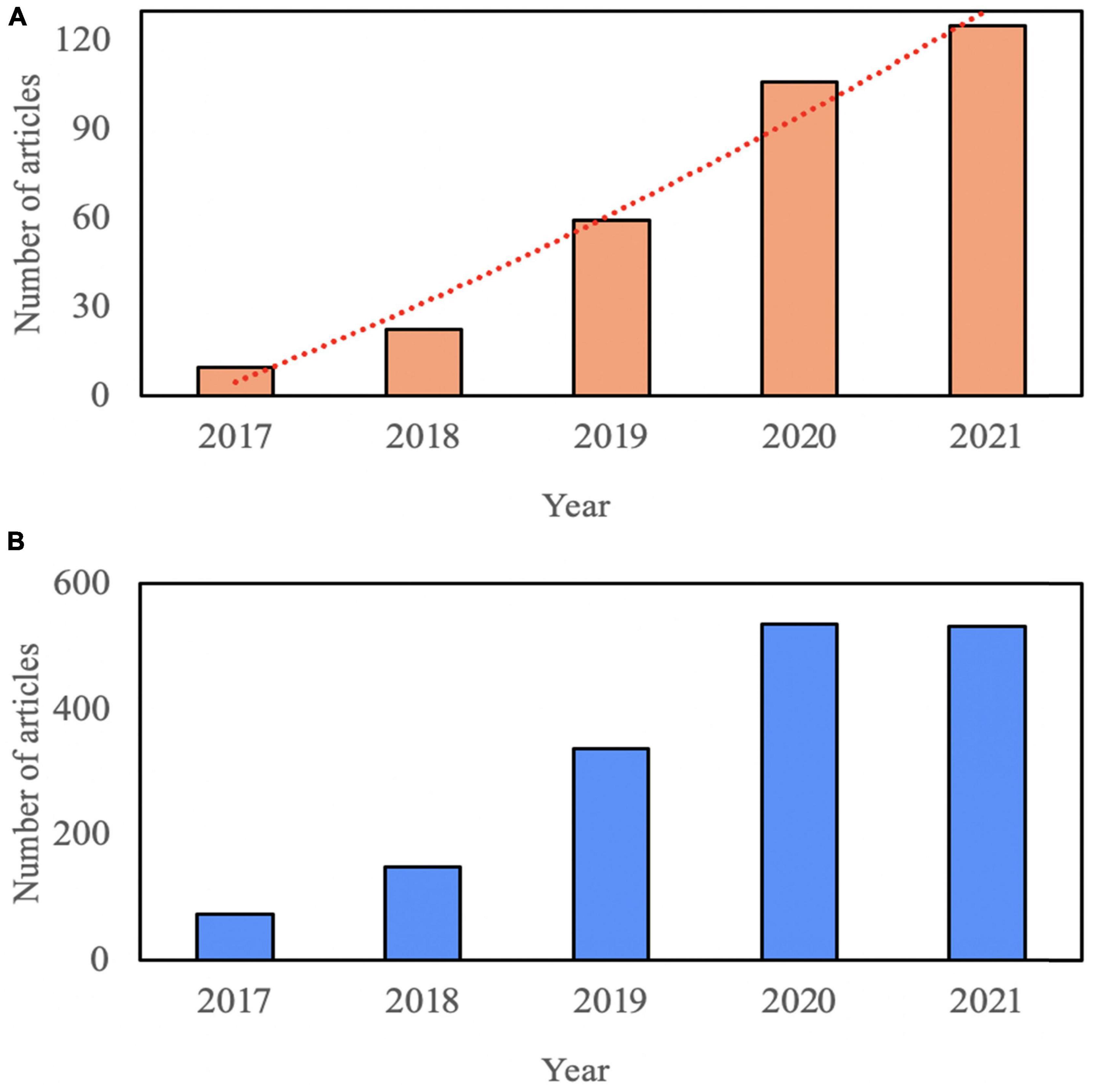
Figure 7. Trends of articles published (A) in E.D. 4.0 and (B) in Engineering Education and E.D. 4.0.
RQ4: How do E.D. 4.0 efforts compare between developing and developed countries?
It is evident that there are socio-economic differences between developing and developed nations, and these were especially exacerbated during the COVID-19 pandemic (Gajdzik et al., 2020; Perry et al., 2021). Our bibliometric analysis, which centers around search words such as “Education 4.0,” “Education Engineering” and associated E.D. 4.0 core components, reveal that these research efforts are predominantly conducted in developed countries, as compared to their developing counterparts (63 and 51.2% of published articles, respectively). In our classification, we use the conventional definition of developed countries, as those nations which have a Human Development Index (HDI) equal to, or exceeding 0.8 (United Nations, 2022a,b). Figure 8 shows the most recent values of the HDI, for all countries. The countries which score highest in this criterion are the US, Canada, Australia, the United Kingdom, Ireland, Japan, South Korea, and countries typically comprising the European Union (Austria, France, Sweden, Germany, Finland, Norway, Denmark, Iceland, Spain, and Italy). Trailing slightly lower are some other countries, some of whom are known to have oil export economies (Russia, Kazakhstan, Saudi Arabia, Turkey, Argentina, Chile, Portugal, Croatia, Romania, Bulgaria, etc.). The shift of the world toward online, technocentric learning environment toward E.D. 4.0, arising as a direct result from our bibliometric analysis, is presented in Figure 9. A rather different perspective emerges, and three countries (the US, China, and Australia) emerge as locations where this shift has occurred the fastest. A surprising contender is India, which, despite still being a third-world economy, has adapted seamlessly toward a techno-centric economy, thereby also influencing a shift toward E.D. 4.0 measures within the country. But this shift is also somewhat expected, since a significant proportion of the world’s programming and information technology (IT) needs are exported to employees in India. After India, some other first-world nations (the United Kingdom, Spain, Germany, Canada, Russia, and Finland) follow. Indonesia also ranks in this list (and this means that the country is moving toward the successful implementation of E.D. 4.0 competencies as identified from our bibliometric analysis), despite not being traditionally considered as a first-world nation. Predominantly, we observe research efforts in developed nations to mainly tackle the ICT core component (71.6%), as against the Competencies counterpart (52.1%) (ITU, 2022).
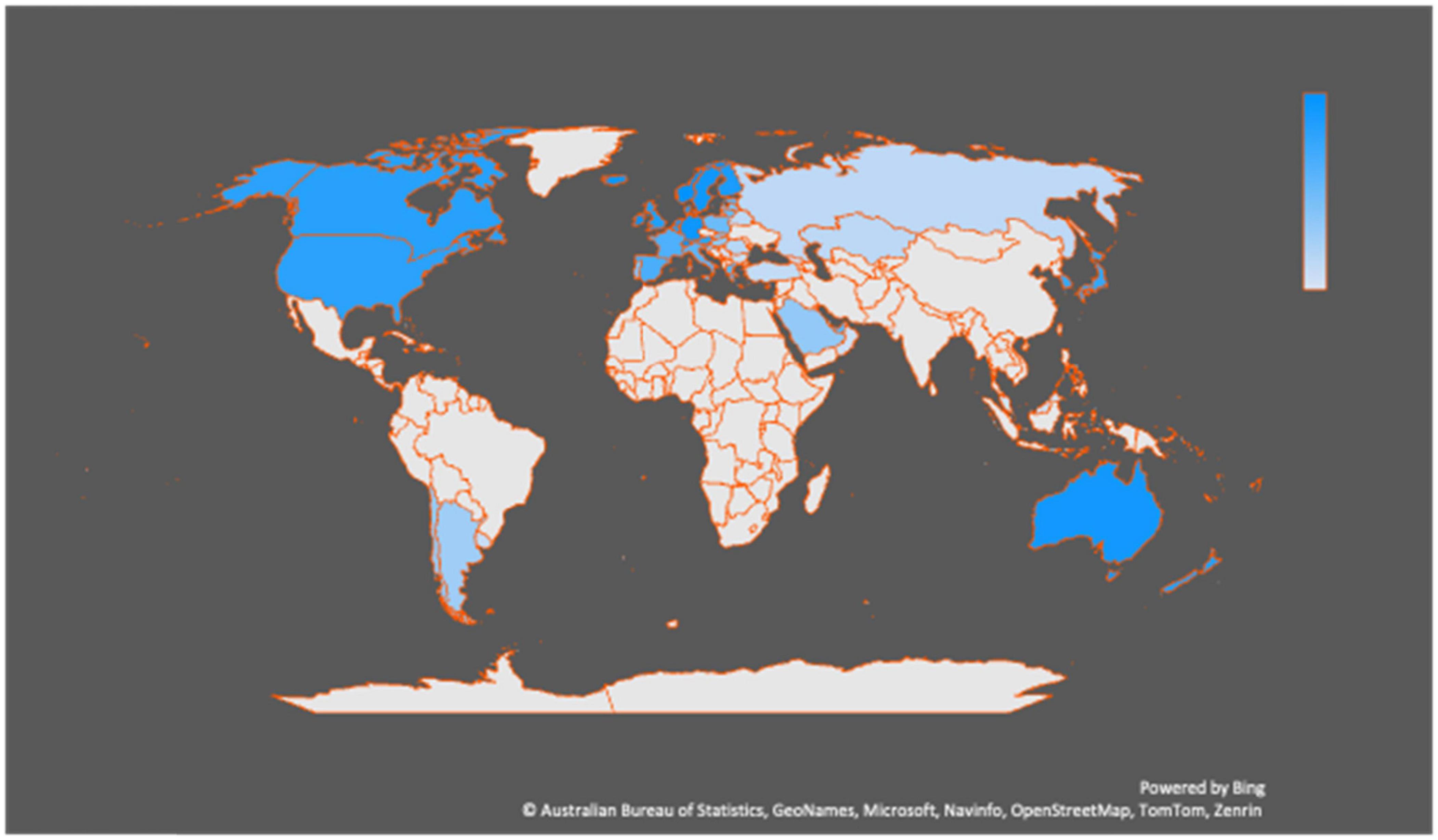
Figure 8. Global distribution of the Human Development Index (HDI), as of 2022. As expected, the HDI is stronger for developed economies.
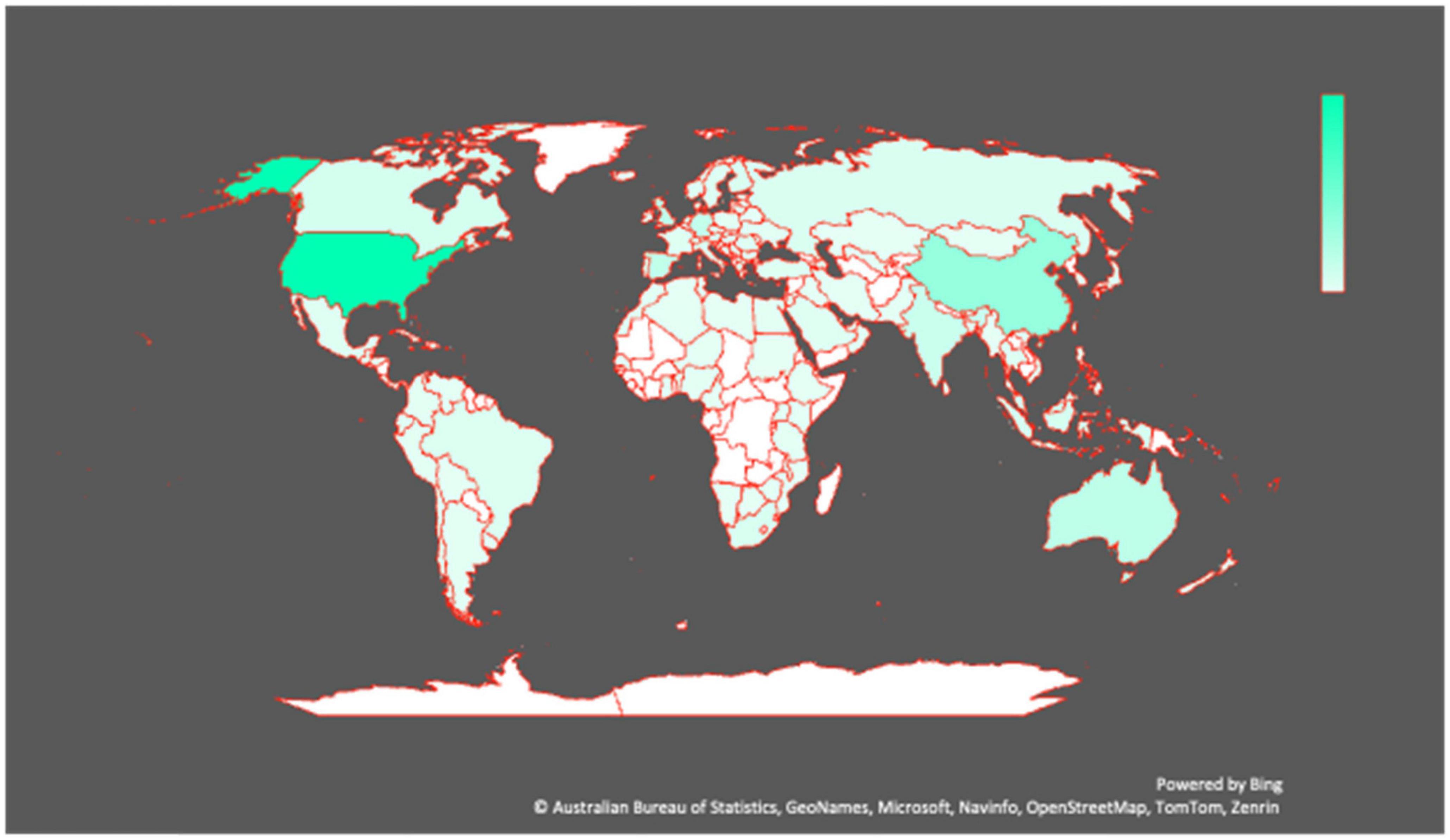
Figure 9. Global map representing efforts by countries toward the adaptation of online learning-based E.D. 4.0 environment.
When Figures 8, 9 are compared, an interesting conclusion arises: some first-world nations are yet to revamp their pedagogical and university-based education to meet the demands of I.D. 4.0. As the world becomes increasingly more digitized, we identify that several first-world economies hold immense potential to train future skilled workers who can address the current global I.D. 4.0 demand shortage – some of these being Canada, France, Brazil, South Africa, Japan, Italy, Sweden, Norway, Turkey, Saudi Arabia, and Mexico. We clarify here that our analysis is limited by the available data online, and as countries change their global positioning and strategic outlook toward the E.D. 4.0 metrics, as identified by our analysis, these conclusions will evolve over time. It may be worthwhile to perform separate bibliometric analyses within each country and compare which sectors of E.D. 4.0 feature prominently across which states/provinces. Very likely, national economics and the overall industrial asset mix will dictate which aspect of E.D. 4.0 is valued by a nation, when training a generation of students to match its I.D. 4.0 demands.
5. Discussion
The network map that seeks to answer RQ1 (Figure 2) show that defined clusters do not necessarily match core E.D. 4.0 components, although its elements are clearly found when linked to these clusters. This graphically strengthens the evidence toward implementation of E.D. 4.0 elements, but no formal E.D. 4.0 framework to map with I.D. 4.0 exist currently. The unbalanced weight distribution in the clusters, show heavier contributions for the clusters “performance,” “methodology,” and “internet,” overshadowing other critical elements included in the groups quality and curriculum. Moreover, the identified missing elements do not necessarily relate to the lack of implementation of E.D. 4.0 core components but instead occur due to not adopting a standardized E.D. 4.0 definition/framework.
Further evidence of this claim is obtained from the network map that aims to answer RQ2 (Figure 3), where no universally adopted educational framework appears to fully encapsulate and capture I.D. 4.0 needs; however, efforts to match I.D. 4.0 requirements with E.D. 4.0 training which can suitably prepare the workforce in higher education institutions have been massively adopted. Both maps in Figures 2, 3 reveal that these efforts might result in discrepancies when assessing the effectiveness of implementing core components, item weight imbalances, potential duplication of elements, and mismatch with I.D. 4.0 priorities. Therefore, it is recommended to periodically update the reference framework to capture the evolution of the I.D. 4.0 requirements; task must be consensually defined under a standardization process. However, a summarization of the major weighted clusters (which are the closest match to I.D. 4.0 requirements), may form a definition for E.D. 4.0 (also summarized in Figure 10).
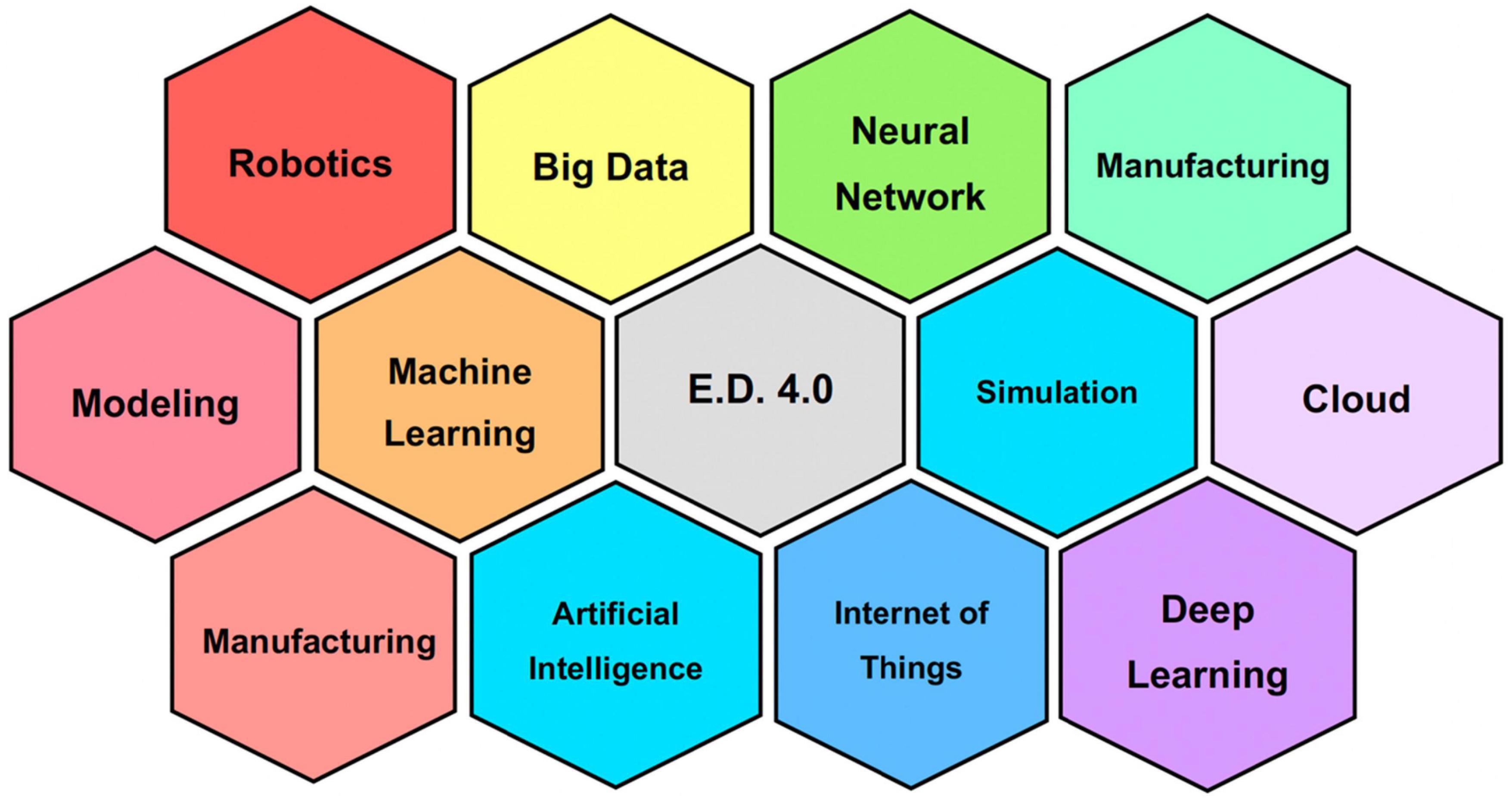
Figure 10. Current components of E.D. 4.0, as identified by bibliometric analysis. These elements form the most updated markers of E.D. 4.0 and align closest with the current requirements of I.D. 4.0.
5.1. Definition
Education 4.0 is an educational framework that strategically incorporates competencies such as mathematics, modeling, AI, simulation, ML, the IoT, deep learning, big data, neural network, manufacturing system, robotics, motivation, cloud, etc. into the learning experience, to match the current requirements of I.D. 4.0.
It must be immediately emphasized that this definition is not cast in stone, is by no means exhaustive, and is likely to evolve with time, depending on I.D. 4.0 demands. As of today, this current definition of E.D. 4.0 appears to be extremely reasonable (even to the lay observer), and in tandem with global industrial trends which favor a move toward a more digitized, computer-based economy and workspace. This is also one of the key tenets of the vision of E.D. 4.0, as detailed by Fisk (2017) who imagines a future scenario where “man and machine align to create new possibilities.” Therefore, we have demonstrated that bibliometric analyses may be employed to arrive at a (hopefully) universally accepted definition of E.D. 4.0, which will of course need periodic recalibration/updates (say every 5 years, or perhaps a decade). Also, bibliometric analyses can prove useful to inform the pedagogical process across universities and institutions of higher learning, to revamp course curricula in accordance with ever-evolving new market demands/trends, which directly translate to shifts in I.D. 4.0 trends.
It must be immediately emphasized that this definition is not cast in stone, is by no means exhaustive, and is likely to evolve with time, depending on I.D. 4.0 demands. As of today, this current definition of E.D. 4.0 appears to be extremely reasonable (even to the lay observer), and in tandem with global industrial trends which favor a move toward a more digitized, computer-based economy and workspace. This is also one of the key tenets of the vision of E.D. 4.0, as detailed by Fisk (2017) who imagines a future scenario where “man and machine align to create new possibilities.” Therefore, we have demonstrated that bibliometric analyses may be employed to arrive at a (hopefully) universally accepted definition of E.D. 4.0, which will of course need periodic recalibration/updates (say every 5 years, or perhaps a decade). Also, bibliometric analyses can prove useful to inform the pedagogical process across universities and institutions of higher learning, to revamp course curricula in accordance with ever-evolving new market demands/trends, which directly translate to shifts in I.D. 4.0 trends.
To answer RQ3, we refer to Figures 7A, B, which capture the growth trends over the last few years, highlighting the increasing interest and support from researchers/educational institutions in preparing a skilled workforce that can not only meet, but also exceed I.D. 4.0 expectations. This may either be formally stated as E.D. 4.0 efforts, or by conducting research on these core components, as has been the norm within engineering education. An in-depth analysis of the context and context of the significant increase in publications in 2020 and 2021 in Figure 7A, shows that the COVID-19 pandemic accelerated the implementation of ICT elements (for instance, meeting platforms like Zoom and Microsoft Teams emerged as major global players in this sector, and continue to do so even now), as these elements allowed teachers and students to minimize educational disruption, while parallelly tuning teaching-learning strategies and hybrid pedagogical methods. Researchers are already on their way to evaluating the impact(s) of this paradigm shift on the education industry (Oleksiyenko, 2021; Reimers and Marmolejo, 2022). At first sight, the impact of COVID-19 cannot be observed in the overall publication trends shown in Figures 7A, B. However, a restricted search in the identified database, by adding specific keywords such as e-learning, blended learning methods, digital tools, virtual labs, and online assessments, clusters them into one distinct group, which increased 76.2% of components researched between the years 2020 and 2021, as compared to the whole decade. This sudden jump was the response of pedagogical researchers, following the COVID-19 pandemic. The prevalent components fit mainly into the category of Learning Methods in Modalities.
When answering RQ4, the inequality evidenced in the trends of E.D. 4.0-related published articles might be related to higher ICT indexes in developed countries compared to developing countries, facilitating the implementation of technology-based solutions, and using tools and platforms to support learning modalities and methods. At a regional level, Europe appears to lead research efforts in E.D. 4.0 and Engineering Education per capita (176 and 1313, respectively), as measured as the number of related publications per billion, followed by Oceania (114 and 982), North America (105 and 615), South America (47 and 152), Asia (39 and 143), and Africa (9 and 54). Moreover, 26.9% of all the articles were published under Open Access (OA) modality, and 64.5% of these OA articles were published in developed countries. The number of published research articles might not be the sole evidence of the inequality in implementing E.D. 4.0 between developed and developing countries, but it correlates with the findings of other researchers on evaluating barriers and challenges that impede the universalization of this framework (Bogoviz et al., 2019; Costan et al., 2021; Perry et al., 2021; Wakamo, 2022). Hence, our research results also support increasing efforts to identify, analyze, and tackle systematic barriers toward implementing I.D. 4.0 – E.D. 4.0 in developing countries to reduce education and skills-based inequality. Our work promises to serve as a good reference not only in Europe (which appears to lead in E.D. 4.0 measures), but also for several other continents/countries, owing to the generic nature of the analysis, and its global applicability, simplicity of analysis, and reproducibility. Most importantly, the practical implication of these results will lead to an immediate streamlining of the engineering education research, while providing a robust, comprehensive, reproducible analysis procedure that may be successfully employed toward further global studies. Such a framework will also prove valuable for researchers to compare their pedagogical observations. Currently, there is no universally agreed upon framework, thus, comparisons are at best only qualitative, and no quantitative comparisons are possible: our procedure overcomes this limitation and incorporates both comparison methods. Additionally, the obtained competencies of E.D. 4.0 are likely to be consistent with industry trends: for instance, today’s global workspace seems to be strongly dominated by AI/ML, and these form a strong component of the E.D. 4.0 definition. The promise of a successful mapping between E.D. 4.0 and I.D. 4.0 through our procedure is apparent from the fact that the most influential industry trends, as observed today, form part of the bibliometric analysis inferred definition of E.D. 4.0, which may be interpreted as a successful attempt toward “defining” E.D. 4.0, as interpreted and valued by industries today.
From these in-depth discussions, a global perspective of E.D. 4.0 emerges, as applicable to today’s word. Bibliometric analysis also enables us to classify our identified E.D. 4.0 competencies, into two clusters – syncretic and supportive (as shown in Figure 11). What we observe is that most of the identified cluster components are predominantly influenced by ICT based technologies, and related tools and platforms (as expected). The relative “mix” of each of these supportive cluster competencies are summarized in Figure 12, and additional major insight(s) are gathered.
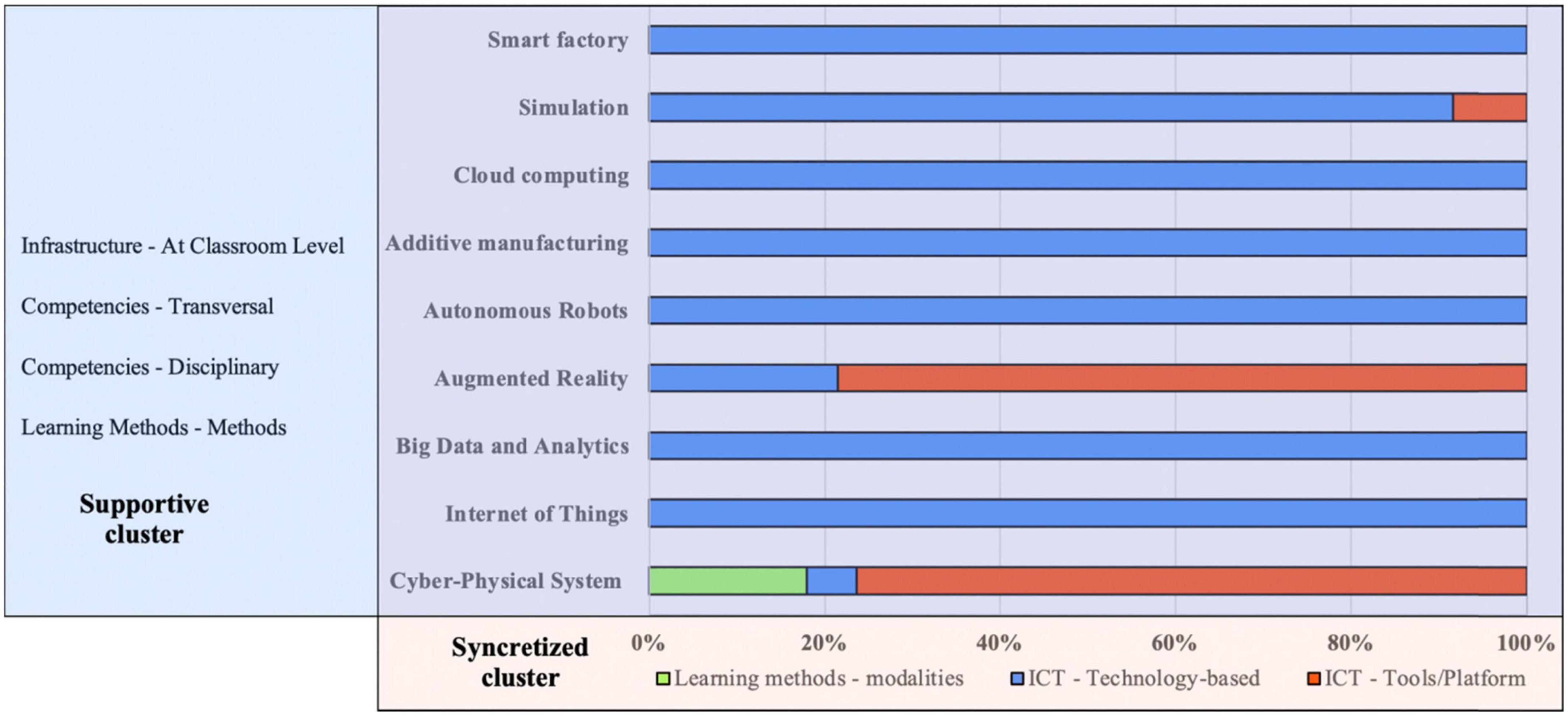
Figure 11. Syncretized and supportive clusters, identified post bibliometric analysis, to map I.D. 4.0 requirements, to E.D. 4.0 core elements.
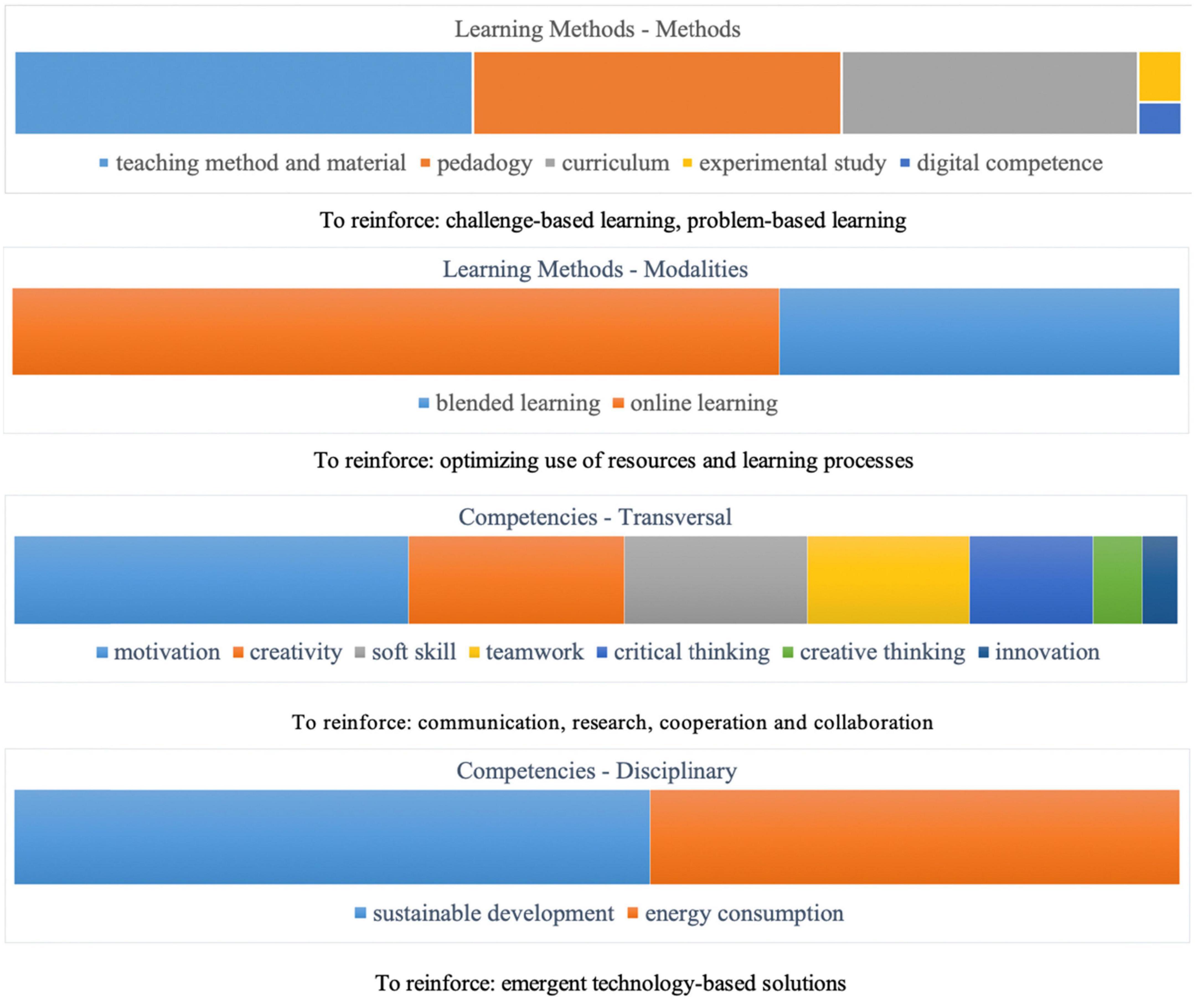
Figure 12. Recommendations arising from classification and analysis of E.D. 4.0 clusters. Each of these bars represent graphically the relative abundance/deficit of contributory components toward a specific competency.
For Learning Methods – Methods: There appears to be a conscious shift toward a revamp of curricula and conscious pedagogical studies. However, experimental study and digital competence score lower; this means that future methods should aim to foster challenge-based and problem-based learning strategies, in additional to existent pedagogical methods, to provide students with a holistic learning experience, while simultaneously empowering them to meet I.D. 4.0 demands in the future.
• For Learning Methods – Modalities: There is a slight advantage that online-learning has, compared to blended learning. This trend is in complete accordance with the E.D. 4.0 clusters identified by our bibliometric analysis. It appears that this aspect is almost balanced, and the only recommendation is to optimize the use of proper resources, to facilitate the learning experience for students.
• For Competencies – Transversal: There are several contributory components identified – motivation, creativity, soft skills, teamwork, critical thinking, creative thinking, and innovation. First, it is worth observing that creative thinking has taken a backseat, with the advent of a more digitized global workspace. This should be regarded as a global concern, and future pedagogical research should be strategically implemented to foster this extremely crucial skill among future students. Collaborative skills also score lower (a natural consequence of the individual, work-from-home, online workspace that the COVID-19 pandemic ushered in), and students must be also taught the values of communication, research, cooperation, and collaboration in a world that is becoming increasingly individualistic, when it comes to working style. These are important areas for pedagogical researchers to base their future works on.
• For Competencies – Disciplinary: There is an almost balanced perspective of energy consumption and sustainable development. However, with the emergence of greener technologies (blue/green hydrogen, biofuels, bio-refineries, etc.), we recommend incorporating emergent (green) technology-based solutions into future course curriculum.
6. Conclusion
The lack of standardization toward defining an E.D. 4.0 framework, for mapping I.D. 4.0 requirements continues to remain an extremely important issue, as has been reiterated in the literature. The conclusions arising from the work of Silva et al. (2021) reveal several initiatives that characterize an alignment of E.D. 4.0, to meet I.D. 4.0 demands. Such initiatives tend to (a) protagonize the student, (b) incentivize active learning, (c) propose the development of practical initiatives, (d) develop skills that are relevant in the 21st century, and (e) enable experiences with emerging computationally aligned resources/processes. Such efforts should be strategically targeted to furnish students with educational skills and assets that are more aligned to I.D. 4.0 needs, to enable maximum chances of employability.
In this work, we propose a method to define E.D. 4.0, through a reverse-engineering of the problem. Rather than attempting to describe E.D. 4.0 competencies from scratch, a bibliometric analysis on the relevant literature provides us clusters, which then form the basis for our definition of E.D. 4.0. Our approach of identifying an integrated reference framework as a source for identifying these E.D. 4.0 elements (clustered across four components) by merging the most up-to-date efforts of Kipper et al. (2021) and Miranda et al. (2021) is non-discriminatory. Over time, as I.D. 4.0 competencies evolve, the same exercise may be repeated after identifying suitable previous reference frameworks, to obtain a more representative definition of E.D. 4.0, as and when required. Verification of the constituent components of the reference framework is implemented using a detailed bibliometric analysis spanning over 1,965 articles, which provides graphical indicators on mapping E.D. 4.0 skills to I.D. 4.0 demands. The advantages of such a bibliometric approach make our analysis global (results are not geographically restricted), and simultaneously, provide a measure of the effectiveness of implementing core components, as VOSviewer can efficiently analyze large volumes of data and provide insight on implementation trends, under minimal time. A detailed analysis of the graphs generated reveals that some of the generated element clusters fall outside the proposed framework, suggesting that the definition of E.D. 4.0 must be expanded to incorporate these clusters as well. Evidence of these additional E.D. 4.0 clusters arising out of bibliometric analyses, outside of any currently accepted formal (and somewhat more theoretical) E.D. 4.0 framework, proves the lack of standardization currently toward defining an exhaustive E.D. 4.0 framework. Thus, further research toward identifying and comprehensively defining these new clusters is needed, otherwise a mapping with the requirements of I.D. 4.0 is likely to remain imbalanced. The extent of universal adoption of the currently existent E.D. 4.0 framework is also assessed, and a clear gap is identified between developed and developing countries, in terms of successful adoption of this framework currently. Our conclusion, which independently arises out of an exhaustive bibliometric analysis, quantitatively supports the (more) qualitative trends observed by prior researchers. In summary, the integration of bibliometric analyses tools toward comprehensively identifying a global definition of E.D. 4.0 is a paradigm shift in the field and is the first holistic technique to capture all elements. Once a robust definition of E.D. 4.0 is formulated, and receives universal consensus, future academics can then map out E.D. 4.0 to I.D. 4.0’s requirements.
Data availability statement
The original contributions presented in this study are included in the article/Supplementary material, further inquiries can be directed to the corresponding author.
Author contributions
SC: conceptualization, methodology, results, analysis, and writing. YG-T and JM: conceptualization, analysis, and proofreading. DG: conceptualization, analysis, writing, proofreading, and principal investigator. All authors contributed to the article and approved the submitted version.
Conflict of interest
The authors declare that the research was conducted in the absence of any commercial or financial relationships that could be construed as a potential conflict of interest.
Publisher’s note
All claims expressed in this article are solely those of the authors and do not necessarily represent those of their affiliated organizations, or those of the publisher, the editors and the reviewers. Any product that may be evaluated in this article, or claim that may be made by its manufacturer, is not guaranteed or endorsed by the publisher.
Supplementary material
The Supplementary Material for this article can be found online at: https://www.frontiersin.org/articles/10.3389/feduc.2023.1150190/full#supplementary-material
References
Agrawal, S., Sharma, N., and Bhatnagar, S. (2021). “Education 4.0 to Industry 4.0 Vision: Current trends and overview,” in Proceedings of ICEM 2020: recent advances in smart manufacturing and materials (Berlin: Springer Singapore), 475–485. doi: 10.1007/978-981-16-3033-0_45
AnTosz, K. (2018). Maintenance–identification and analysis of the competency gap. Eksploatacja Niezawodnośé 20, 484–494. doi: 10.17531/ein.2018.3.19
Bauer, W., Hämmerle, M., Schlund, S., and Vocke, C. (2015). Transforming to a hyper-connected society and economy–towards an “Industry 4.0”. Proc. Manuf. 3, 417–424. doi: 10.1016/j.promfg.2015.07.200
Beke, E., Horvath, R., and Takacs-Gyorgy, K. (2020). Industry 4.0 and current competencies. Naše Gospodarstvo Econ. 66, 63–70. doi: 10.2478/ngoe-2020-0024
Bogoviz, A. V., Osipov, V. S., Chistyakova, M. K., and Borisov, M. Y. (2019). “Comparative analysis of formation of industry 4.0 in developed and developing countries,” in Proceedings of the industry 4.0: industrial revolution of the 21st century, 155–164. doi: 10.1007/978-3-319-94310-7_15
Costan, E., Gonzales, G., Gonzales, R., Enriquez, L., Costan, F., Suladay, D., et al. (2021). Education 4.0 in developing economies: A systematic literature review of implementation barriers and future research agenda. Sustainability 13:12763. doi: 10.3390/su132212763
Da Costa, M. B., Dos Santos, L. M. A. L., Schaefer, J. L., Baierle, I. C., and Nara, E. O. B. (2019). Industry 4.0 technologies basic network identification. Scientometrics 121, 977–994. doi: 10.1007/s11192-019-03216-7
Das, S., Kleinke, D. K., and Pistrui, D. (2020). “Reimagining engineering education: Does industry 4.0 need education 4.0?,” in Proceedings of the 2020 ASEE virtual annual conference content access. doi: 10.18260/1-2-35136
Ejsmont, K., Gladysz, B., and Kluczek, A. (2020). Impact of industry 4.0 on sustainability—bibliometric literature review. Sustainability 12:5650.
Fisk, P. (2017). Education 4.0 the future of learning will be dramatically different, in school and throughout life. Available online at: https://www.peterfisk.com/2017/01/future-education-young-everyone-taught-together/ (accessed July 25, 2022)
Gajdzik, B., Grabowska, S., Saniuk, S., and Wieczorek, T. (2020). Sustainable development and Industry 4.0: A bibliometric analysis identifying key scientific problems of the sustainable Industry 4.0. Energies 13:4254.
Galatro, D., Chakraborty, S., Yan, N., Goodarzi, N., Castrucci, J., and Saban, M. (2022). “Education 4.0: Integrating codes, standards, and regulations in the chemical engineering curriculum,” in Proceedings of the canadian engineering education association (CEEA) (Toronto, Canada).
González-Pérez, L. I., and Ramírez-Montoya, M. S. (2022). Components of education 4.0 in 21st century skills frameworks: Systematic review. Sustainability 14:1493.
Grzybowska, K., and Łupicka, A. (2017). Key competencies for industry 4.0. Econ. Manag. Innov. 1, 250–253. doi: 10.26480/icemi.01.2017.250.253
Hecklau, F., Galeitzke, M., Flachs, S., and Kohl, H. (2016). Holistic approach for human resource management in Industry 4.0. Proc. Cirp 54, 1–6. doi: 10.1016/j.procir.2016.05.102
Hernandez-de-Menendez, M., Morales-Menendez, R., Escobar, C. A., and McGovern, M. (2020). Competencies for industry 4.0. Int. J. Interact. Design Manuf. 14, 1511–1524. doi: 10.1007/s12008-020-00716-2
Himmetoglu, B., Aydug, D., and Bayrak, C. (2020). Education 4.0: Defining the teacher, the student, and the school manager aspects of the revolution. Turk. Online J. Distance Educ. 21, 12–28. doi: 10.17718/tojde.770896
Hirschi, A. (2018). The fourth industrial revolution: Issues and implications for career research and practice. Career Dev. Q. 66, 192–204. doi: 10.1002/cdq.12142
ITU (2022). The ICT development index. Available online at: https://www.itu.int/en/ITU-D/Statistics/Pages/IDI/default.aspx (accessed July 25, 2022)
Janik, A., and Ryszko, A. (2018). “Mapping the field of Industry 4.0 based on bibliometric analysis,” in Proceedings of the international business information management association conference (IBIMA), Vol. 32. doi: 10.3390/foods11193137
Jerman, A., Pejiæ Bach, M., and Aleksiæ, A. (2020). Transformation towards smart factory system: Examining new job profiles and competencies. Syst. Res. Behav. Sci. 37, 388–402. doi: 10.1002/sres.2657
Kipper, L. M., Iepsen, S., Dal Forno, A. J., Frozza, R., Furstenau, L., Agnes, J., et al. (2021). Scientific mapping to identify competencies required by industry 4.0. Technol. Soc. 64:101454. doi: 10.1016/j.techsoc.2020.101454
Lin, W. D., and Low, M. Y. H. (2021). “An integrated engineering education alignment model towards Industry 4.0,” in Proceedings of the international conference on industrial engineering and operations management, 1204–1213.
Maisiri, W., and van Dyk, L. (2020). “Industry 4.0 competence maturity model design requirements: A systematic mapping review,” in In Proceedings of the 2020 IFEES world engineering education forum-global engineering deans council (WEEF-GEDC) (Piscataway, NJ: IEEE), 1–6. doi: 10.1109/weef-gedc49885.2020.9293654
Mian, S. H., Salah, B., Ameen, W., Moiduddin, K., and Alkhalefah, H. (2020). Adapting universities for sustainability education in industry 4.0: Channel of challenges and opportunities. Sustainability 12:6100. doi: 10.3390/su12156100
Miranda, J., Navarrete, C., Noguez, J., Molina-Espinosa, J. M., Ramírez-Montoya, M. S., Navarro-Tuch, S. A., et al. (2021). The core components of education 4.0 in higher education: Three case studies in engineering education. Comput. Electr. Eng. 93:107278. doi: 10.1016/j.compeleceng.2021.107278
Neaga, I. (2019). “Applying Industry 4.0 and Education 4.0 to engineering education,” in Proceedings of the canadian engineering education association (CEEA). doi: 10.24908/pceea.vi0.13859
Oleksiyenko, A. (2021). “Global higher education and COVID-19: A virtual autoethnography of a faculty,” in Proceedings of the teaching and learning in higher education during COVID-19 (Milton Park: Routledge), 167–180. doi: 10.4324/9781003125921-16
Perry, B. L., Aronson, B., and Pescosolido, B. A. (2021). Pandemic precarity: COVID-19 is exposing and exacerbating inequalities in the American heartland. Proc. Natl. Acad. Sci. U.S.A. 118:e2020685118. doi: 10.1073/pnas.2020685118
Prifti, L., Knigge, M., Kienegger, H., and Krcmar, H. (2017). “A competency model for “industrie 4.0” employees,” in Proceedings der 13th internationalen tagung wirtschaftsinformatik (WI 2017), J. M. Leimeister and W. Brenner (Hrsg.) eds (St. Gallen: University of St. Gallen), 46–60.
Ramirez-Mendoza, R. A., Morales-Menendez, R., Iqbal, H., and Parra-Saldivar, R. (2018). “Engineering Education 4.0:—proposal for a new Curricula,” in Proceedings of the 2018 IEEE global engineering education conference (EDUCON) (Piscataway, NJ: IEEE), 1273–1282.
Ramírez-Montoya, M. S., Castillo-Martínez, I. M., Sanabria-Z, J., and Miranda, J. (2022). Complex thinking in the framework of Education 4.0 and Open Innovation—A systematic literature review. J. Open Innov. 8:4. doi: 10.3390/joitmc8010004
Reimers, F. M., and Marmolejo, F. J. (2022). University and school collaborations during a pandemic: sustaining educational opportunity and reinventing education. Berlin: Springer Nature, 357.
Silva, D. E., Lopes, T., Sobrinho, M. C., and Valentim, N. M. C. (2021). Investigating initiatives to promote the advancement of education 4.0: A systematic mapping study. CSEDU 1, 458–466. doi: 10.5220/0010439704580466
Uhlemann, J., Costa, R., and Charpentier, J. C. (2019). Product design and engineering in chemical engineering: Past, present state, and future. Chem. Eng. Technol. 42, 2258–2274. doi: 10.1002/ceat.201900236
United Nations (2022a). Human development index. Human development reports. Available online at: https://hdr.undp.org/data-center/human-development-index#/indicies/HDI (accessed July 25, 2022).
Van Eck, N. J., and Waltman, L. (2007). “VOS: A new method for visualizing similarities between objects,” in Proceedings of the 30 th annual conference of the gesellschaft für klassifikation eV, freie universität Berlin: Advances in Data Analysis (Berlin: Springer Berlin Heidelberg), 299–306.
Verner, J. M., Brereton, O. P., Kitchenham, B. A., Turner, M., and Niazi, M. (2012). “Systematic literature reviews in global software development: a tertiary study,” in Proceedings of the 16th international conference on evaluation & assessment in software engineering (EASE 2012) (London: IET), 2–11. doi: 10.1049/ic.2012.0001
VOSviewer (2022). Visualizing scientific landscapes. Available online at: https://www.vosviewer.com/ (accessed July 25, 2022)
Waaijer, C. J., van Bochove, C. A., and van Eck, N. J. (2011). On the map: Nature and Science editorials. Scientometrics 86, 99–112.
Wakamo, B. (2022). Get the facts on inequality and covid-19. Available online at: https://inequality.org/facts/inequality-and-covid-19/ (accessed July 25, 2022).
Wallner-Drewitz, T., and Wagner, G. (2016). “Academic Education 4.0,” in Proceedings on the international conference on education and new developments Ljubljana 2016.
Wilke, A., and Magenheim, J. (2017). “Requirements analysis for the design of workplace-integrated learning scenarios with mobile devices: Mapping the territory for learning in industry 4.0,” in Proceedings of the 2017 ieee global engineering education conference (EDUCON) (Piscataway, NJ: IEEE), 476–485. doi: 10.1109/educon.2017.7942890
Keywords: Education 4.0, Industry 4.0, mapping, systematic literature reviews, bibliometric analysis, pedagogy, engineering education, higher education
Citation: Chakraborty S, Gonzalez-Triana Y, Mendoza J and Galatro D (2023) Insights on mapping Industry 4.0 and Education 4.0. Front. Educ. 8:1150190. doi: 10.3389/feduc.2023.1150190
Received: 23 January 2023; Accepted: 30 March 2023;
Published: 20 April 2023.
Edited by:
Wang-Kin Chiu, The Hong Kong Polytechnic University, Hong Kong SAR, ChinaReviewed by:
Nicoleta Duta, University of Bucharest, RomaniaHideyuki Kanematsu, National Institute of Technology, Suzuka College, Japan
Copyright © 2023 Chakraborty, Gonzalez-Triana, Mendoza and Galatro. This is an open-access article distributed under the terms of the Creative Commons Attribution License (CC BY). The use, distribution or reproduction in other forums is permitted, provided the original author(s) and the copyright owner(s) are credited and that the original publication in this journal is cited, in accordance with accepted academic practice. No use, distribution or reproduction is permitted which does not comply with these terms.
*Correspondence: Daniela Galatro, ZGFuaWVsYS5nYWxhdHJvQHV0b3JvbnRvLmNh
 Sourojeet Chakraborty
Sourojeet Chakraborty Yris Gonzalez-Triana
Yris Gonzalez-Triana Jorge Mendoza
Jorge Mendoza Daniela Galatro
Daniela Galatro